#a lot of it is about the visual symbolism rather than the actual. spiritual kind
Photo
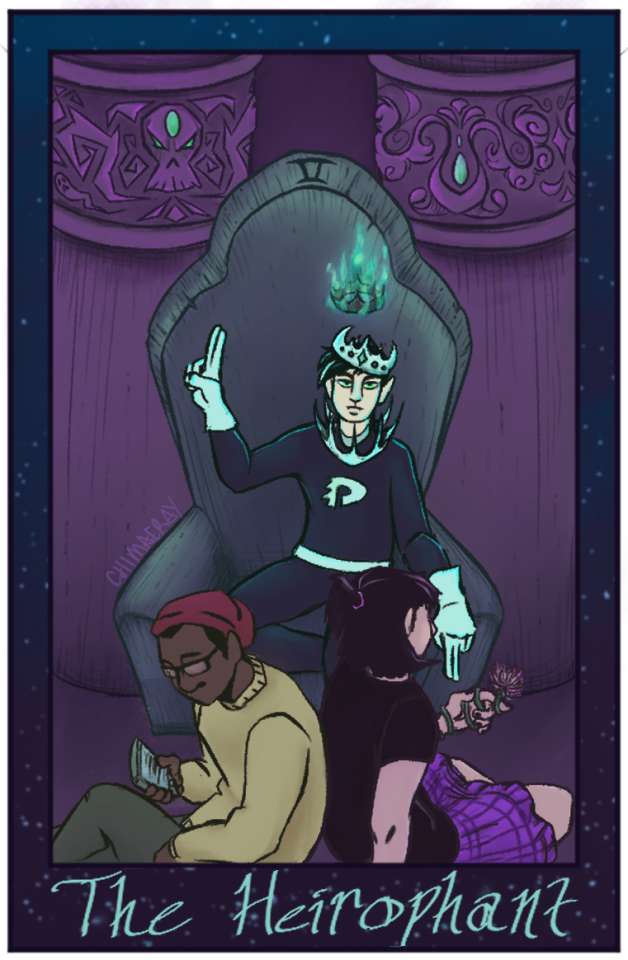
Dannymay day one: Different Style
OKAY okay this is one of those things that I started working on and I kept increasing it’s scope because I got excited about it, but I think it turned out well! It was gonna be a one to one of the card but obviously that didn’t happen haha.
Some symbolism stuff under the cut 👀
It started out with the pillars in the background, their carvings follow a similar basic pattern but are inverse of one another.
One of course follows more of the ghost zone designs with a full skull, and strange polygonal shapes with a few softer ones thrown in.
The second is more organic to be like life, flowing and softer, but a few polygonal shapes to mirror back to the other side.
The original Heirophant card I was referencing, from the Rider-Waite deck, shows the priest in a three-tiered crown. Danny got three “tiers” of crowns as well!
Of course there’s Danny pointing to the heavens and to earth, classic “As above so below” imagery. This is an exaggeration of something already present in the original card, of course, but it’s fun when Danny is a balance of life and death
Sam has her back turned to the viewer, slightly looking up. She’s more closed off to other people, but she’s receptive to change and often instigates it.
She’s usually the one seeing the consequences of actions before the boys, looking forward to see what could happen next.
The flower she’s holding was originally inspired by Dahlias--which can symbolize new beginnings, diversity from the mundane, enduring kindness, and devotion to good.
While all these qualities sound good for Danny and Team Phantom in general, I also chose this one because of the association with Black Dahlias, making it still reference death as well.
Tucker is facing the viewer, looking down at his PDA-phone hybrid. He’s more receptive to others, and actually has a few references to friends outside of the trio! He also seems to be more anchored in the world, often distracted by his tech. He sees a lot of what affects the now, and worries more about that instead of what the future might bring.
And Danny himself is fully facing the viewer, seeing the scope of things often and trying to encapsulate both sides of it all. He’s relaxed, maybe bored, in his posture, but still upholds “as above, so below” with firm gestures.
He might not be fully comfortable here, but he’s devoted to it regardless.
This ties more into the Heirophant’s actual meanings, generally divinity and goodness but specifically alliance, servitude, mercy, inspiration. Reversed it can be society, concord, overly kind or even sacrificial, and weakness.
but these all tie back into the constant message of duality and balance that is shown in The Heirophant’s card and how Danny really is in the middle of it all.
#danny phantom#dannymay2022#dannymay#king danny#danny fenton#tucker foley#sam manson#myart#obviously my symbolism chatter only really includes a total outsiders perspective from a little googling#I could absolutely missed some marks and that's fine#a lot of it is about the visual symbolism rather than the actual. spiritual kind#which is kinda funny for a card that's literally all about spirituality I guess#but its my art and I get to choose the symbols#I had some other things I wanted to talk about but I've forgotten them now unfortunately#anyway I;m a little late because the scope kept increasing and all#but I am doing fics for the next few days so hopefully those'll get turned out and posted here soon#I already know I'm not gonna do all the days but I will certainly do my best#also I think its important for everyone to know:#this image is named the Heirophantom
176 notes
·
View notes
Text
wwdits tarot: the high priestess
The third meta post in my wwdits tarot series! I’ll keep making them as long as y’all keep reading them. lmao
Because this came up with the first two posts, I just wanted to say that I’m thrilled if you want to use this information/interpretation to create cards. Tarot is largely a visual medium, and while I’m happy to talk about what I know about the history and symbolism, I’m not a great visual artist myself. I have no plans to create cards myself, so I’m happy to see what you come up with!
I only ask that if you use my ideas, you credit me for them and link to my work. And again, because it’s been asked — if you plan on using my ideas to make money, uhhh… just contact me, okay? We’ll talk about it.
Anyway! II. The High Priestess!
The High Priestess is often paired with The Magician because both cards deal with “magic” of a kind, but while The Magician is about manifesting your inner desires in the outer world, The High Priestess is about setting the outer world aside for a moment and looking within. It’s a card about intuition and the divine inner feminine, regardless of the actual gender of the person giving or getting the reading.
It’s also one of those very liminal cards; it’s about the inner world more than the outer world, but it’s also about the power to pass between those worlds whenever you like.
With all that in mind, I’ve chosen Lilith as my High Priestess.
Because when I think about magic, the unknown, and the divine feminine… why not think about a cadre of underground witches who steal semen for use in magical spells? lmao
I also chose Lilith because, like ghosts, witches serve as a lesson in-universe to trust your feminine intuition. Nadja is constantly talking about dangers that might befall the household, and she’s often dismissed as superstitious by the men around her. And you know what? She’s always! Right!
So trust your intuition, Nadja. Enemies abound in New York City. Five spits for an enemy, Lilith.
Finally, I feel like the witches in general but Lilith in particular do really symbolize the ability to shift between worlds. The vampires are really very hopeless at disguising themselves amongst the humans, but the witches are fabulous at it. They blend in seamlessly with the human world while simultaneously existing in the supernatural one, and they very literally go between these worlds when they descend into their magical… dungeon or whatever. And like any good liminal trickster deity, they’re great at changing their physical appearance.
They also have the ability to create a weird interdimensional space that they can trap (non-Spanish-speaking) interlopers in! So literally and metaphorically, they make great spiritual go-betweens. Lilith is the queen of the liminal magical space, and I love that for her.
As for the card imagery…
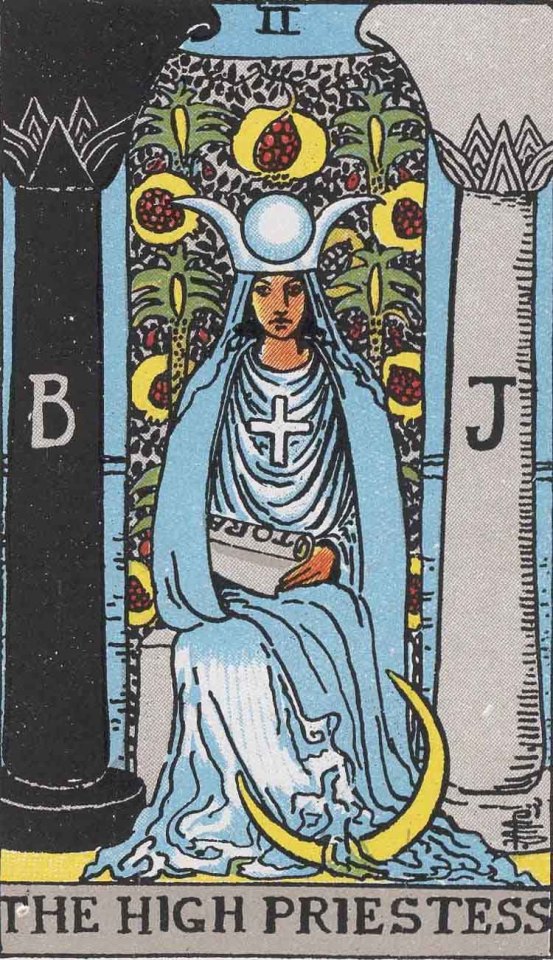
YEAH, IT DOES LITERALLY HAVE BJ ON IT...
This is technically a reference to the pillars of Boaz and Jachin, which were popularly repurposed as occult symbols at the time, but I think it suits our witches and their semen-stealing ways very well. :)
There’s honestly a lot of occult symbolism in this card in particular, and I won’t get into all of it. I’ll just say that most of it refers to different kinds of dualism. Light and dark, good and evil, male and female, life and death, etc. The High Priestess sits between all of these dualities, a midpoint and a path between. She can lift the veil, she can eat the pomegranate, she can sit between two pillars. You get what I’m saying. Our girl is liminal as all hell.
I think we definitely need to keep the BJ, but I would have Lilith in her witch’s garb between B&J columns in her underground witch dungeon/hip-hop kundalini* studio. Rather than her crown, she has her witch's hat. Rather than a sacred scroll (implying divine knowledge), my girl is holding penile surgical instruments. We can keep the crescent moon for the vibes, tbh, but I do like the idea of a hidden SALIDA sign somewhere on the card — for when you’re ready to return to the real world.
----------------------
*Fun fact: kundalini is a form of yoga that prioritizes the divine feminine so that's another point in the High Priestess column!
wwdits tarot meta masterpost
#I also considered the Nadja doll for this one#she's also a good one for liminality the divine feminine and quite literally listening to yourself#but being real with you she terrifies me so#wwdits#wwdits tarot
13 notes
·
View notes
Text
Restless Rewatch: The Untamed, Episode 26, part two
(Masterpost) (Other Canary Stuff)
Warning! Spoilers for All 50 Episodes!

Content note: This episode has a lot of lightning, but this post does not have lightning flashes--I’m using mostly stills for those parts, or I’ve snipped out the unfriendly frames before giffing.
Qing-Jie
Having successfully ruined Jin Guangshan’s party plan to get the Yin Tiger seal, Wei Wuxian dashes off to tell Wen Qing where her brother is. She hops up to hit the road with him, but then sorta-faints because she’s starving. In a rare moment of tenderness between these two, he catches her and gently sits her down again.
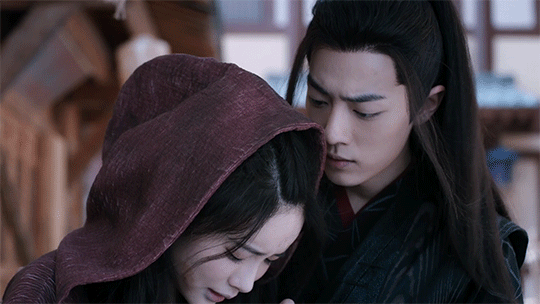
Normally they’re busy out-toughing each other, both before and after this moment, but right now Wen Qing is openly vulnerable. Wei Wuxian responds to that, predictably, with all of his kindness and with his usual slew of unwise, impossible-to-keep promises.

As she eats the bread he’s brought her--a parallel to an important piece of bread in his early life--he says they have to believe in Wen Ning’s survival. Cut to: Wen Ning, not surviving.
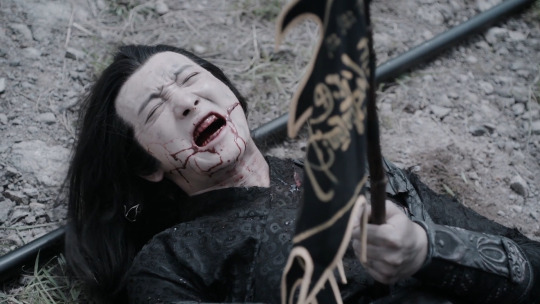
I mean, yes, yes, he’s only mostly dead, but he’s never going to be fully alive again, so.
24 Hour Party People
Back at the party, Jin Guangyao, deliberately, I think, goes to offer his pops a drink while his pops is still super furious and looking for someone to take it out on. The servant lady is like, better you than me, pal, and helps JGY get his drink ready. Pops, predictably, knocks the drink onto Jin Guangyao.

(more behind the cut)
Lan Xichen is standing by with a hanky and a face full of worry. Lan Xichen is so Lanny that he thinks JGY needs to go change clothes after getting clear alcohol spilled on him, rather than just letting it evaporate and smelling pleasantly of booze for the rest of the evening like a normal party guest.

JGY launches into a criticism of Wei Wuxian, which Lan Wangji listens to very carefully, frowning. Lan Xichen, Nie Huasang and Jiang Cheng listen as well, and don’t speak up.
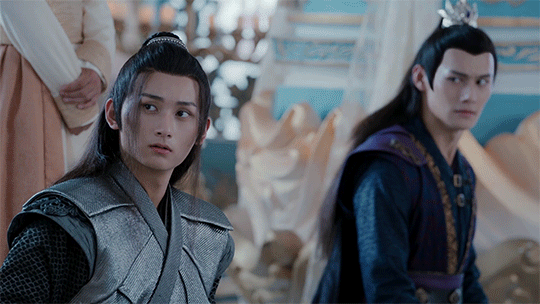
A Clear Conscience
Then Lan Wangji *literally* steps out of his brother’s shadow, and speaks in defense of Wei Wuxian. This right here is Lan Wangji’s turning point, as far as I’m concerned. Xichen is gazing at JGY, totally on board with JGY’s spin of the situation, and his shadow falls away from Lan Wangji’s face as LWJ steps forward.
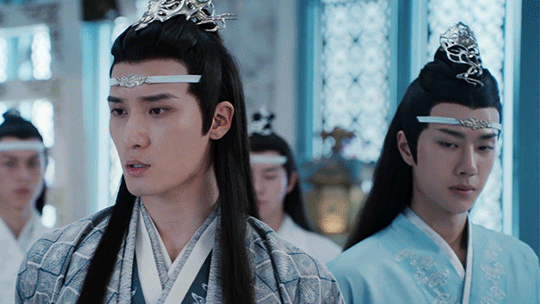
Lan Wangji says, isn’t what WWX said true? JGY puts on his customer service smile and says that the truth isn’t something you’re supposed to go around saying out loud.
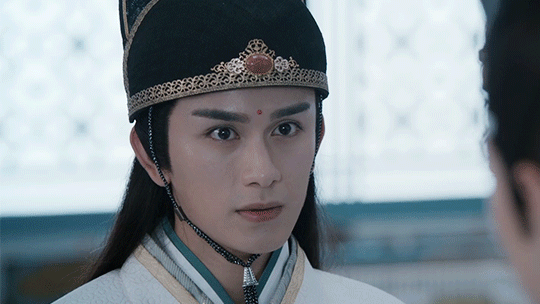
I’d like to say this is what’s wrong with cultivator society but this is really a universal human thing; every society has rules about upsetting the social order, and they are very frequently at odds with basic compassion and morality.
Nie Huaisang and Jiang Cheng stay silent but Lan Xichen goes and throws Wei Wuxian under the bus carriage, saying his character has changed.

Lan Wangji nods decisively at this, and bows to Lan Xichen, silently asking permission to follow Wei Wuxian. Lan Xichen grants permission, telling Lan Wangji to do his best. Lan Xichen probably thinks he and Lan Wangji are in agreement, in this moment, but that nod of Lan Wangji’s was nothing of the kind.

That nod was Lan Wangji agreeing with himself; he is going to try to bring Wei Wuxian back but he is also going to listen to him. Meanwhile Lan Xichen is tying himself in knots to appease Jin Guangyao. The divergence between the brothers will just grow, from this point onwards.
Lan Wangji leaves to go follow his boyfriend conscience, while Jiang Cheng continues to silently listen to the commentary of others, and gets so mad he crushes a wine cup.

It Was A Dark and Stormy Night.
Wen Qing and Wei Wuxian arrive at the prison camp, and the first person they encounter is Granny, with a defaced Wen Banner in her hand and Wen Yuan on her back.
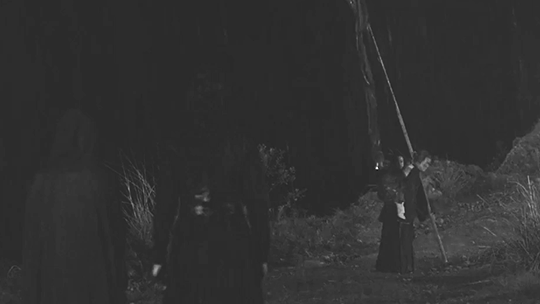
Whenever I read a meta or a fic that talks about how the juniors are so sweet partly because they are “untouched by the war” I want to point to this moment. A-Yuan endures an absolute truckload of war trauma by the time he’s four years old, and while Wei Wuxian and Lan Wangji both deserve a lot of credit for saving him at great risk to themselves, Granny and Uncle Four are the first heroes of A-Yuan’s story. His kind, mellow personality has a lot in common with theirs.
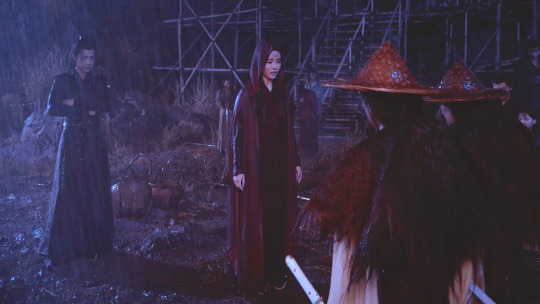
This is followed by an eternity of Wen Qing running around asking if anyone’s seen her brother. Eventually Wei Wuxian gets tired of this and gathers the guards together, threatening them with Chenqing.

He doesn’t need to play it; just holding it up has every Jin dude instantly kneeling and scared.

The guards send him and Wen Qing go to a giant field of corpses, where Wen Qing runs around checking to see if any of them is her brother. Wei Wuxian starts off kind of detached and angry, but eventually snaps out of it, tucks away his flute and starts helping her to search.
Wen Qing finds Wen Ning, mostly-dead with a lure flag speared into his belly. Wei Wuxian grimly takes in the situation from across the field of corpses.
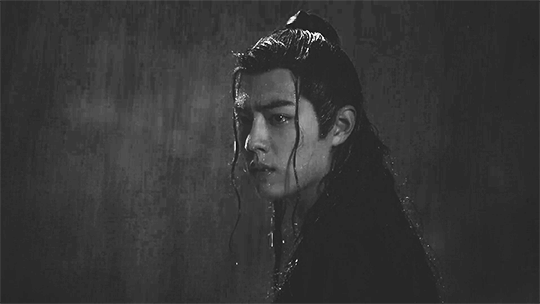
When he arrives at Wen Qing’s side he sees this talisman in Wen Ning’s hand.
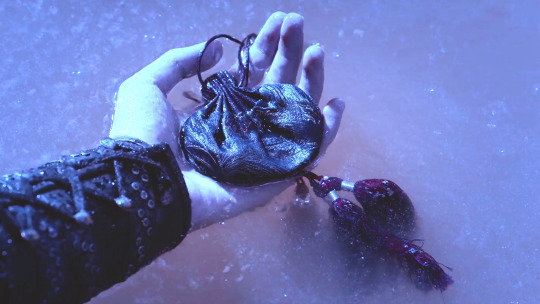
This is the talisman that Wei Wuxian made for Wen Ning back in Gusu summer school, before the war. It’s the one that Wen Ning was wearing at his waist when they met up after the massacre of Lotus Pier. It’s supposed to literally protect Wen Ning from having his spiritual consciousness snatched, as well as being a symbol of Wei Wuxian’s sense of responsibility for, and affection for, Wen Ning.
Wei Wuxian, understandably, loses his shit at this point. Less understandably, he is about to decide that the best way to express his sorrow and rage is to re-animate the corpse of his friend, right in front of the corpse’s sister. Like, seriously, dude. Dude.
Ghost General
This super-questionable decision leads to one of the most badass sequences in the show, which is unfortunately chock full of lightning flashes, so not everyone can watch it. Wei Wuxian and his flute and swirls of resentful energy come marching out of the darkness of the corpse field, back to the guards.
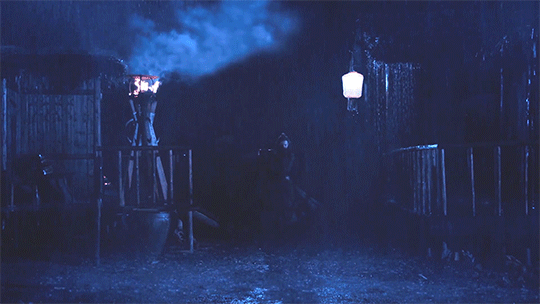
The guards have decided to slaughter all of the prisoners and then run away, which would be a good plan except they should really have skipped right to the running away part of things. When Wei Wuxian accuses them of killing the prisoner in the corpse field, they claim that the Wens have a habit of falling off of a hill and dying. Wei Wuxian can relate.

At this point Wei Wuxian summons up Wen Ning 2.0, ultra badass edition, who comes flying through the air with his odd, straight-armed fighting stance and cool solid-black eyes and rock-and-roll hair.
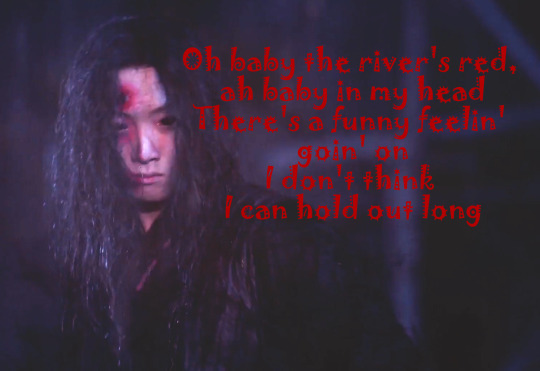
Soundtrack: *Four Sticks*
Wen Ning proceeds to whale on the guards and scare the shit out of his relatives.

Then Wen Qing shows up and begs Wei Wuxian to stop. She explains that Wen Ning is only mostly dead. Like, if he was fully dead would she be okay with this?

Wei Wuxian tries to reel Wen Ning in and realizes that he is not actually in control of Wen Ning. Ok, see, right from the first day of Wen Ning 2.0, WWX is aware that his control is iffy. Why does he think he’s going to be able to control him later?

Anyway, this is where we learn Wen Ning’s grown-up name is Wen Qionglin. Wei Wuxian yells this name, and Wen Ning looks up like a cat hearing the “food noise,” and then proceeds to get control of himself.
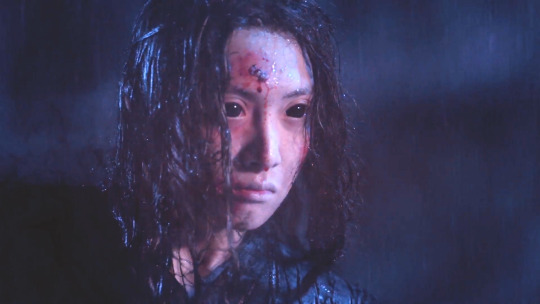
This is such a nice symbolic moment, that will be replayed later in the temple, when Wen Ning saves Jin Ling from Baxia.
Wen Ning has a remote-code-execution OS vulnerability throughout the story; his soul is at risk of being stolen, and he is magically controlled by Wei Wuxian, Xue Yang, Su She, and Baxia. Meanwhile Wen Qing, Wei Wuxian, and random kids on the street mostly treat him as a child, despite his clear adult capabilities. Wen Ning’s journey in The Untamed is at least partly about asserting his full adulthood, and his ability to overcome magical control is directly connected to that journey.
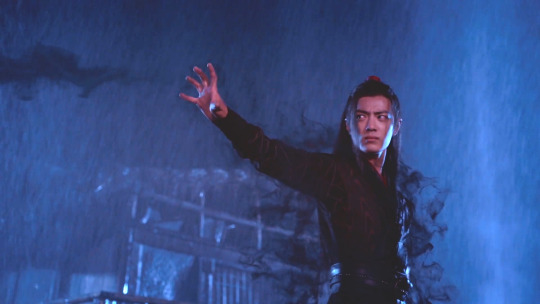
After getting Wen Ning to chill, Wei Wuxian calls the floating resentful energy back into his own body, which looks about as comfortable as swallowing a burp.
On the plus side, apparently resentful energy keeps your hair dry even when it’s raining.
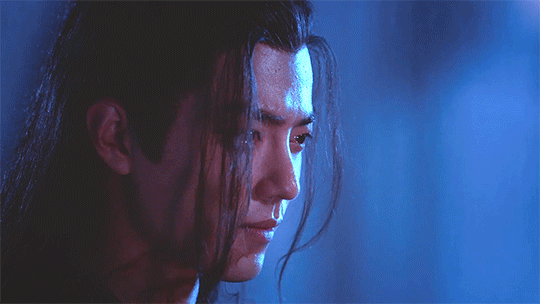
Wei Wuxian should take a page from the guards’ book and slaughter all the Jin witnesses to this situation, but he decides to be the better person and let them live. They go running off down the road, where they encounter Lan Wangji and give him the 411, saying that Wei Wuxian resurrected dead people.
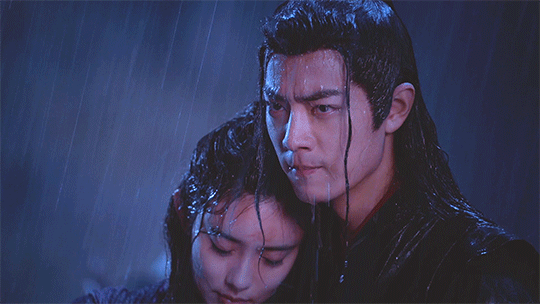
Meanwhile Wei Wuxian collects Wen Qing--half-fainted, again, in an echo of the start of their journey--and collects the Dafan Mountain Wen group, who are hiding, wisely. When they see Wen Ning, Uncle Four and some others start to freak out, but Wei Wuxian tells them that fierce corpses are cool, and they all grab horses and mount up.
Where Are You Going?
Lan Wangji is waiting for them, nonconfrontationally indulging in some visual poetry while he waits.
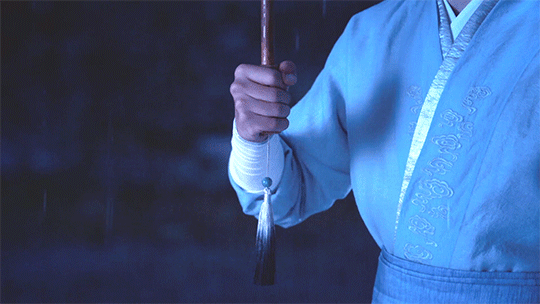
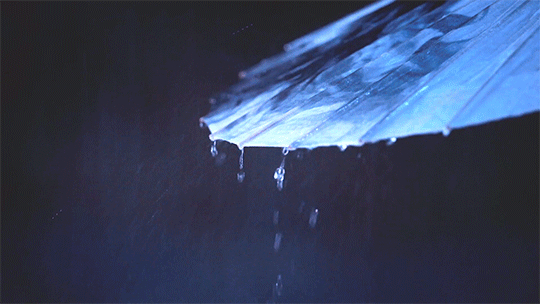
In a show where every prop is exquisitely, carefully designed to enhance our understanding character, his Gusu-toned umbrella reveals surprising red and yellow threads woven in, right above his eye line as he looks at Wei Wuxian.
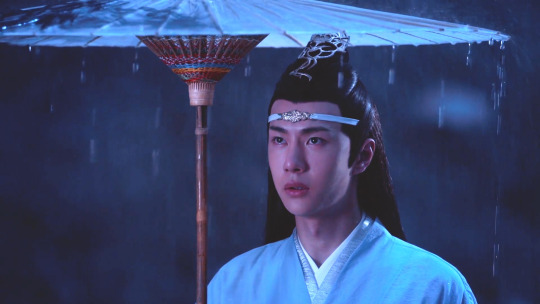
Wei Wuxian speaks first, saying “you came to stop me?” Lan Wangji doesn’t answer, but asks him where he’s going. Then Lan Wangji warns him that he’s about to abandon orthodoxy forever, if he follows through.
Wei Wuxian challenges this idea of orthodoxy, asking if Lan Wangji remembers the promise they made together, back in Gusu. It’s worth noting that they both appear to think of it as a co-promise, even though Lan Wangji didn’t speak aloud at the time.
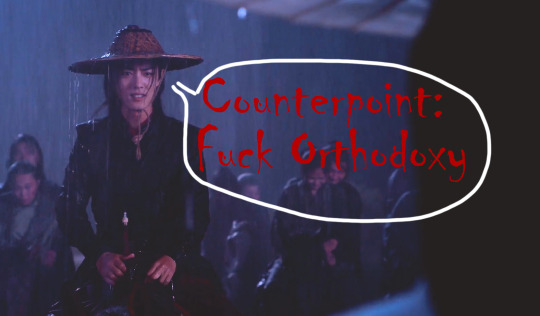
The conversation will continue in the next episode, because what’s better than a rainy romantic cliffhanger?
Soundtrack: Four Sticks by Led Zeppelin
#the untamed#the untamed gifs#wangxian#wen ning#restless rewatch the untamed#canary3d-original#my gifs#episode 26
196 notes
·
View notes
Note
The 40K fandom filling with alt-righters was predictable because GW won't stop rimming the Imperium at the expense of everyone else, original themes included, but how was Warhammer Fantasy going down the same way?
Its a lot more obvious with 40K because its basically been playing footsie with the Alt Right for decades now by openly embracing Neo Nazi symbolizing and imagery (its more complicated than that but i’m bitter). Warhammer fantasy doesn’t do that, it does draw on Germanic imagery but its more Holy Roman Empire than fascist/Imperial Germany. But it still has some narratives which appeal to fascists, even though the setting was 100% not designed to appeal to fascists (in fact a lot of the fluff is anti fascist). So its not deliberate but here are some default assumptions (I actually wrote a paper on this)
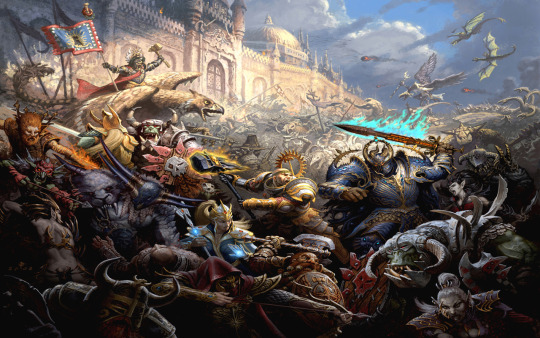
1) The lack of positive Emotions. Warhammer fantasy is a parody and is designed as a dark comedy, and lets admit that a lot of its fluff is very funny. But one of the problems with creating a setting where everything sucks and everybody is a bastard, is that it actually encourages the sort of nihilistic understanding of humanity which Neo Fascism (opposed to classic fascism) relies on so much. This is a world where diplomacy doesn’t work, kindness is foolish, and decency is unrewarded, all that matters is cruel war. And as a cynic myself, I can appreciate the joke they are going for, but the longer that joke goes on, the more it makes caring about humanity seem foolish. This also combines with the hatred of cute stuff (see also Doom). The Entire world view is very adolescent boy, which is about the emotional state of fascism.
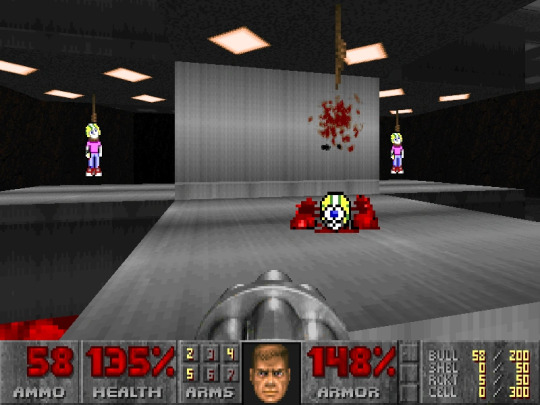
2) For all of the games cynicism, it has a soft spot towards the glory of war. The world is shitty, incompetent, stupid, cruel, unjust and random, but Warhammer Fantasy tends to depict war as the only transcendental and glorious experience. This is most exemplified with the Chaos Warriors, who come off as rather noble despite being a faction whose entire existence is defined by war. Warhammer fantasy mocks many things but never war

3) It very much buys into the “Warrior Culture” myth (Seen also Conan), where some cultures are defined macho and violent opposed to softer and more civilized cultures. The Northern cultures near the Chaos wastes get this a lot. These cultures have a very “noble savage” way of writing, especially regarding the Viking/mongol based ones.

4) The background of the Empire of Man still buys into the conservative perspective of “Things were great in the past, but society steadily fell”. It actually takes this further because it attributes the fall to decadence, hedonism, and sexual immorality. I was just reading Historian and conservative shithead Niels Ferguston, who wrote
“the real threat is posed not by the rise of China, Islam or CO2 emissions, but by our own loss of faith in the civilization we inherited from our ancestors.” and that sort of view about what causes civilizations to fall fits into the Warhammer understanding of history. In fact if you go unto fascit forums, they often describe the Queer movement, especially trans activism, as Slaanesh worshipers
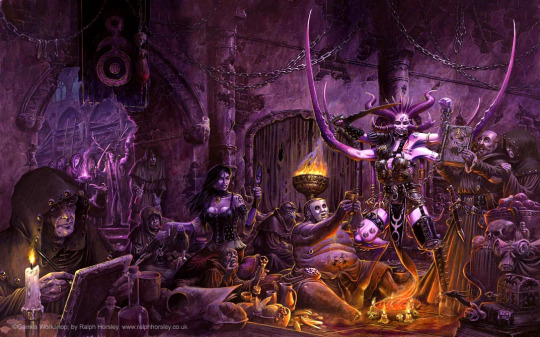
5) While Warhammer fantasy is not overtly sexist and I don’t think any of the writers have actual problems with women (though Games workshop is run by Satan) but the way female characters, especially female sexuality are depicted in the series is...telling. the Dark Elves and Slaanesh worshipers have a very “Sex, especially kinky sex is evil” feel. Now I don’t think the writers of Warhammer fantasy actually have a reactionary view towards sex and aren’t trying to make a fascist point, but I think that narrative supports the fascist narrative that decadence spiritually damages society. The genre is super male coded very strongly and tends to buy into macho notions of aethetic (which Warhammer 40k will take much further)

6) Because warhammer draws so much on real world societies, even by the standards of fantasy, its depiction of those societies is super telling. The Holy Roman Empire as presented in Warhammer is actually both less complicated and less international than its real world counterpart. Notably, the real holy Roman Empire actually controlled Spain and through it the New World, meaning it was by far the most ethnically diverse state in the world during the time of the Reformation. Because its drawing its influence from the Holy Roman Empire rather than more fantastical element (which I will grant gives setting a distinct Aesthetic which I mostly like) it contributes to the warped understanding of “Medievalism” which the Far Right takes advantage of. This is a problem with most fantasy and Warhamer is not alone here, but a lot of people’s default understanding of the Medieval/early modern Era is shaped more via fantasy than by an actual understanding of the era. Notable the intellectual, cultural, artistic...really any non military part of history. Which unfortunately is how a lot of people view the pre modern world, as just military history, which lends itself to conservatism.

7) Its Euro Centric as fuck. That is normal for most fantasy but because Warhammer is so balatant about its real life inspiration, the absence is notable. You have Fantasy France and Fantasy Holy Roman Empire, but you are missing the North African states, the Caliphate, and probalby most important of all, the Ottoman Empire, the greatest Rival to the Holy Roman Empire. The Holy Roman Empire and the Ottoman Empire had a century long series of wars/rivarlys/hatefucking relationship which is just absent. There is mention of a China based nation (Cathay really?) and some sort of Muslim power (Arabay) which the setting doesn’t care about and nobody ever visits. The new World exists, but the native Americans have been replaced by Dark Elves and Lizard People. You are even loss most of the real like ethnic diversity, their are new Jews and the Romani are confined to the Romania inspired vampire setting and basically exist as Bram Stoker people who dabble in dark magic. And the ogres (one of my favorite factions btw) have a very oriental visual design, which would be fine if there were actual asians in the setting. All of the non human races except the Chaos dwarves tend to look white or entirely alien which compounds this problem
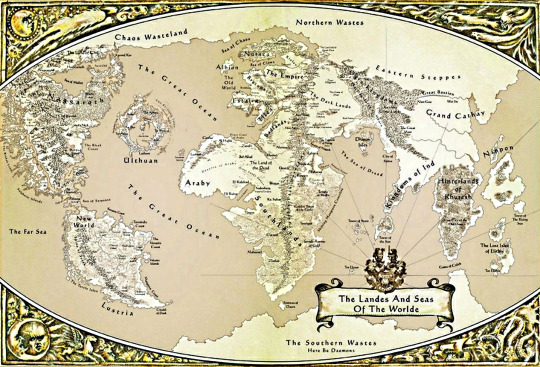
8) The notion of cults. The Witch Hunters in Warhammer Fantasy play much the same role as the Inquisition who targeted Protestants, “Witches” (and in Spain at least) Muslims and Jews. Basically the inquisition was just an exercise in cruelty that just targeted entirely innocent people. In the Warhammer world, Daemon cults are real and the brutal methods of the inquisitions are largely justified, they kill a lot of innocents but they also destroy a lot of cults. This one is something I’m kinda mixed on, because the presence of evil cults dedicated the forces of hell is fun and it is a great plot for adventure, but it has the unintended side effect of making the notion of secret societies dedicated to profane rites seem less silly. Look at how Alt Rightists talk about the supposed leaders of the left, its language that is used to describe the cults in warhammer, I mean the Pizzagate conspiracy theory/Qanon conspiracy theory feel like people talking about Slaanesh and Tzeentch cults
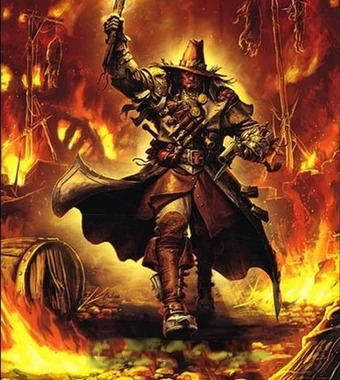
9) Finally, the cynical nature of the setting, combined with its pro war narrative creates a world view where the world is corrupt, cruel, and unfair, the vast majority of people are ignorant morons and the nobles are decadent have weird sexual kinks. the only things holding the forces of hell at bay are the thuggish sadistic cruel soldiers who regularly indulge in torture and murder of civilians, and it is with these people you must trust. Its a brutal world where the only appropriate response is more brutality, which in addition to being ahistorical (the Early modern period was more than just war) but fits the fascist world view. The world is terrible and the only thing you can have faith in is a bunch of German war criminals with a fetish for eagles and skulls. Anybody trying to challenge that world view is either a Daemon Cultist or a naive idiot who is going to be taken over by a Daemon cultist.

(very Wagner)
Again, Warhammer Fantasy is not deliberate fascists, in fact there is a LOT in the material which rejects fascism but there is a lot of thoughtless assumptions that confirms their world view.
Also I never played/read Age of Sigmar so i don’t know if this carries over

#ask EvilElitest#Warhammer Fantasy#warhammer 40k#Holy Roman Empire#games workshop#Alt Right#Fascism#Conservatism#Daemon Cults#Pizzagate#Gamergate#Chaos Cults#Chaos Gods#nurgel#slaanesh#khorne#Tzeentch#Malice#Malal#empire of man
34 notes
·
View notes
Text
ADHD Meditation
As some of you may know, the path I am on has, of late, been tending towards the druidic, and druidic paths, being shamanistic, involve, for lack of a better term, a heck of a lot of meditation. As some of you may also know, I also happen to have combined Inattentive-Hyperactive type adult ADHD, which makes meditation really hard.
So I thought I’d write a little primer of meditation techniques that I use. Whether you have ADHD or just can’t get the hang of meditating, I hope these techniques are useful to you!
Meditation: The ADHD Nightmare
The point of meditating is to -- well, to be meditating. When you do it right you reach a “meditative state” (duh), and my understanding is that something wack happens to your brainwaves when this occurs. I don’t know, I’m a writer, not a neuroscientist. Either way, a “meditative state” is a real thing with real effects on your mind and wellbeing.
There are a couple of different ideas of how to get there. “It’s clearing your mind!” people will shout. “You should be sitting there without a thought in your head!” Other people retort, “No! It’s not clearing your mind, it’s sitting and observing everything around you as an impassive observer!” Then yet others say, “No! You observe your breathing and body in order to become one with it!”
Like -- look, there are tons and tons of different kinds of meditation. And yeah, these are legitimate techniques used by different spiritual traditions. They also have the drawback of being boring. Like, rip-your-brain-out-through-your-nose-and-stomp-on-it, oh-my-god-please-let-me-do-something BORING. Of course not everyone’s going to agree with me, and I am willing to admit that these techniques are valuable and useful to certain people. In fact, once you’re used to meditating, you can transition into some of these meditations -- I’ve done a few of them and they are quite pleasant.
But if you’re like me and not having any stimulation makes you want to creep out of your skin backwards, but you just really, really want to meditate -- well, here’s a couple tips.
Walking Meditation
This was the first meditation I ever did, because sitting meditations made me want to die. I personally use a walking stick because it helps emphasize the rhythm of your stride, but you can do it without one, too.
Most Zen walking meditations recommend you pace back and forth along a smooth, straight path. And while the Zen Buddhists are probably much better at this sort of thing than I am, I find that technique to be brain-rippingly boring (not to mention impractical in my present living situation) and I do mine in outdoor open spaces, such as winding nature trails or along lakeshores. The only thing I’d recommend is that you don’t do it anywhere too strenuous -- you want to be focused on the meditation, not on avoiding falling off a mountainside.
Here’s what you do -- start walking.
The trick here is the rhythm of your stride. Rather than just letting your brain do whatever the fuck it wants, count your steps like they’re a musical bar (one-two, one-two, one-two, or maybe left-right left-right), focusing on the sensation of the ground beneath your feet with each step. Whenever your mind starts to drift, which it definitely will, just guide it gently back to your rhythm -- one-two, one-two. Don’t go hitting errant thoughts with a mallet -- just redirect them, like sheep broken off from the flock, to the count. If you find you’ve lost pace (you’re saying “left” when your right foot goes down), stop, take a deep breath, and start again.
My favorite way to do this meditation is with a walking staff, one, because it makes me feel like Gandalf, and two, because it goes down with my right foot (on two, every time) and helps me clearly delineate one “bar” from the next. The vibration of the staff also gives you something else to focus on rather than the soles of your feet -- I tend to wear heavy hiking boots on my walks, and the sensation of the staff hitting the ground actually gives me more of a sense of being grounded than my feet do. Just do whatever works for you.
“Good For You, But I Wanna Sit”
But what if you can’t do a walking meditation? That’s fine, there’s tons of reasons why it might be unfeasible for you, from space concerns to ability concerns to even stuff as simple as “yo, it’s blizzarding”. That’s cool -- I have some tips for “regular” meditation too!
Just know this: You’re not going to be able to “quiet your thoughts”. Hell, if your brain works like mine you’re not even going to be able to “impassively observe”. You won’t be able to focus on your breathing without wanting to scream (”Ok, we’re alive,” says brain, “Cool, still alive, got it. All right, breathing is a thing we are constantly doing, who cares let’s GO.”) All of these tips involve a focus of some kind -- something to bring your brain back to where it needs to be in order to get to that meditative state.
Looking Meditations
I do this one with a candleflame because fire is sick as hell and also interesting to watch. You could probably also do it with fish or something, or really anything you would be cool with staring at for minutes on end. This is the same basic principle as the walking meditation, except here, you’re sitting quietly -- it doesn’t have to be in a lotus position if you don’t want. I’ve meditated sitting in an office chair, kneeling on the ground, sitting criss-cross applesauce, and lying down. Whatever is most feasible and comfortable.
In the walking meditation the Focus was your stride. In this case the Focus is whatever you’re looking at. Rather than bringing your thoughts back to the rhythm of your steps like we did in the walking meditation, you’re herding your errant brainwaves towards the visual focus.
Here, as in many still meditations, you’re going to want to control your breathing as well. Personally, making breathing my focus is a losing proposition, but you’ll meditate more easily if you’re breathing slowly and deeply.
Mantras
“I don’t like looking at stuff,” you might say. “I am literally blind,” you might also say. Cool! So find a mantra! (This term might be appropriative in some way but I can’t find a good substitute -- let me know if someone knows one). This could be a saying, or a phrase, or even a prayer. Whatever it is, I find it most useful if the mantra actually has some symbolic meat to it -- not just “rubber baby buggy bumpers” but something that you’d be able to write a short paragraph about, at least. I personally use Welsh triads (because druid). Once you have your mantra, repeat it, aloud or in your head. Forever. (Or as long as it takes you to start meditating).
Again, breathing is really important here, as in all sitting meditations. Try to breathe slowly and deeply. I frequently find my breathing will begin to match up with the ebb and flow of the mantra, and that’s fine. Just keep that oxygen flow going in a steady rhythm (you don’t have to track the rhythm-- that’s an entirely different meditative technique!)
You might notice something weird will start to happen after a bunch of repetitions. At first this might take a longass time, but it gets shorter the more you practice. You’re thinking about the phrase without really thinking about it -- it starts to take on depths and dimensions that you never would have seen just thinking about it -- congrats, you’re meditating! (In fact -- you’re meditating on the mantra -- in case you had no idea how to do that, here you go!) Do this as long as you feel like it and then return awareness to your room. Don’t just hop right up -- sometimes meditation fucks with your coordination for some reason -- give yourself a few seconds and then go make yourself some tea. You’ve earned it.
Next Steps
In shamanistic practice, achieving a meditative state is often a jumping-off point for journeying or intense visualization. Meditation can be used in concert with these, or it can stand on its own as a daily or weekly practice. Don’t get discouraged if you don’t “get” it the first time! The thing to remember is not to force it -- meditation is born of relaxation, and forcing it will only hinder you.
Once your brain is trained to enter the meditative state more easily, you might find it comparatively simple to transition into more traditional Zen meditations (”CLEAR UR MIND!!”). The trick is practice!
Happy meditating!
#meditation#pagan#witchblr#druidry#spirit work#astral#witchcraft#druidism#obod#heathen#adhd#neopagan#spirituality#add
1K notes
·
View notes
Text

ENTRY #1 SPACE MARINES
And why you ask? Simple. Its easy to hate Space Marines. You know what though, its also easy to forget some of the best things about them that get lost in the current mainstreaming of the lore and GW's pathetic attempts to turn them into noble sci fi heroes.
And so I present to you my; 10 THINGS YOU CAN DO TO MAKE A MORE MEANINGFUL SPACE MARINE ARMY. Good for both Established, AND custom Chapters.

#1: Recruitment:
All Space Marines starts life as humble regular human boys. Aww, arn't they cute? HOWEVER, as we all know, the imperium is vast and has hundreds of millions of worlds. And Space Marine Chapters, being the primidone's they are get first class choice of recruiting worlds. So ask yourself. What world do my boys come from?
Feudal?
Feral?
Hi-tech
Deathworld?
The list goes on. And believe it or not, this has a huge effect on how your marines, even in a established chapter may act. Are they recruited from primitive headhunting cannibal tribes (Azriel)? Or maybe highly learned but well structured societies? Once you know, start thinking about how you can add personal detail to your models and story via the background of where your young soon to be giant super human murder machines came from.
#2 Rituals:
Every Chapter has special "Join our club" rituals. How do you become a Space Marine in this chapter? What effort do you go through, and more importantly, what do you have to show for it? Tokens, totems, perhaps trophies are self forged weapons, armor or tech constructs? Again, the sky is the limit, and can be both modeled on your army and written in the lore.
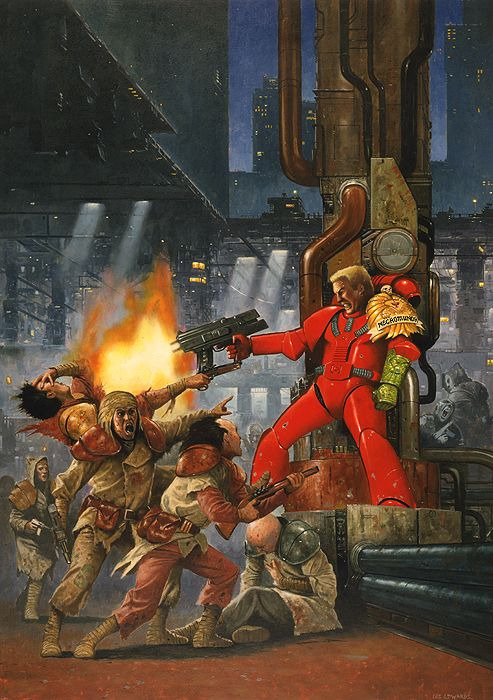
#3 Traditions:
What does your chapter like to do to make everyone feel like part of a fraternity of crazed indoctrinated killing machines?
Perhaps they drink each other's blood. Maybe blood sport. Perhaps hunting trips. Maybe just drinking till the suns come up
What do your boys do as celebration and tradition or observance that sets them apart.
#4 Weapons:
Ah yes, you know you like this one. Weapons. What do your boys prefer killing with? Swords? Axes? BARE FUCKING FISTS? Who knows, only you. But there’s more to it than this. Whats the history? After all the Dark angles have their Edgy Black blades. The Space Wolves have Russ' spear and random relics, and the UltraMarines like their Gladius, but ask yourself, what weapon do your boys prefer and what does it symbolize to them?

#5 Visual Aesthetic:
Knights? Been there done that. Monks, Been there too. Hmm maybe vikings...nah. But hey whatever floats your boat. Ask yourself, what Aesthetic is your marine chapter known for? Dig into it, Go to your history book and look up famous armies and military. Maybe perhaps, even something current gen rather than history? Who knows what you might find. Perhaps you got a thing for Mongols, or perhaps less known Stepp people Like Sythians or such. Maybe you have a thing for an obscure African tribe. Think outside the box and get an idea of what your boys embody
#6 Heraldry:
Yeah this one is easy, Very easy. Or is it? Can you think of a coat of arms that fits your design, And more important, one that can then be simplified down to a model scale and easily free-handed or sculpted?
Every coat of arms and heraldic device in the world means something. What does yours mean? Skulls, yeah cool, whatever, but what about a Skull and a crown, or perhaps a tower with a skull gate? What do those mean to you and your marines and where did it come from?

#7 Doctrine:
No, not the killing kind, more of the belief kind> What do your brothers believe? Is the big E a god to them? Or do they know better? Do they like the high lords and obey them? Or do they think they are a bunch of Bureaucratic assholes that they really are? Do they like the Inqus? Maybe the sisters? Maybe they actually get along with humans. Do they have Spiritualism or Objectivism? Tribalism or maybe something more obscure? What do they believe in that keeps them killing and purging?
#8 Combat Doctrine
Ah yes, the good part. Whats the Combat tactics of your boys? Close Up and Personal? Or maybe lots and lots of guns. ALL THE DAKKA! Who knows, maybe your Marines actually prefer to fight from Orbit. Being only ever deployed during mass Fleet engagements (See 3rd war for Armageddon.) The sky is the limit when it comes to how your boys in Power Armor like to fight and believe it or not, it doesn’t always hav to be....CC or Ranged.
#9 Colors
Take pride in your colors. Or don't and make your marines have cheesy camo schemes like Rogue Trader era shit. Who cares? You wanna know whats boring as fucking? painting all your marines like your trying to replicate the box art photos on the model box. Take it somewhere fun. Study or create squad markings both from 40k and history. Find things that make them apart from all other chapters even if they do fall in line with Girlly-man's Codex. Do they use patterns or straight color schemes, do they mark themselves by squad, or as individuals? Do they have coherency in their scheme or do certain colors designate ones from others? Always remember, Your color pattern is what people will first see.
#10 History
Ah now the most important and last point. History, Yeah remember when 40k was told as a historical game and not like a "We gonna move the story forward but not really" point? Remember when your inner history buff got a hard on reading the Sabbat worlds, or the 12th Black Crusade? remember when you wanted to have a history that meant something? Well you should make one! Study the maps and old codexes, Go through all those short stories you forgot about in various books. Study old classic warfare in our own history and make reasons why your boys are such a big deal, or maybe even a small deal, or perhaps a darker deal in the 41st Millennium.
A story is only as good as its base, and your boys need a solid one if your going to keep yourself and others interested in it.
That’s all for today Heretics! Happy Hobbying!
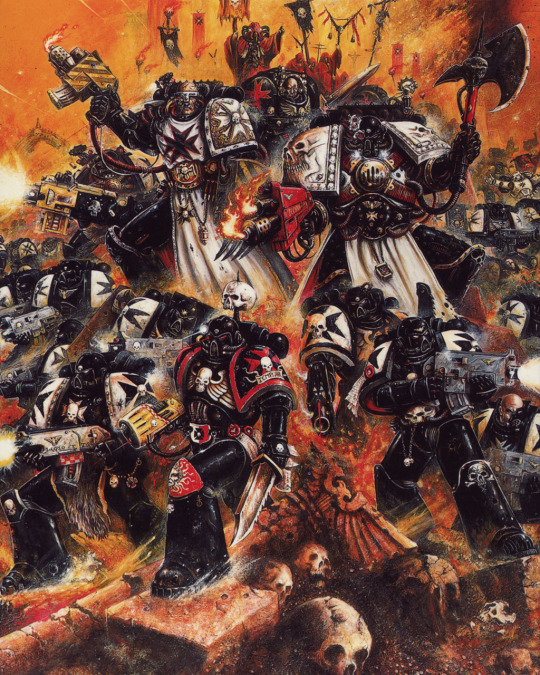
10 notes
·
View notes
Text
All right Ghost and Pals fans I've got a Honey I'm Home theory:
The moth represents Norman's mother, and the song as a whole is a metaphor for being abused by religion.
Let me explain:
[This post contains discussion of religion/cults, abuse, insects, and human torture/experimentation]
Ghost said straight up that there's five new OCs in Honey I'm Home right? Exactly five. It's emphasized a lot.

[Image ID: a screenshot from the description of Ghost's upload of Honey I'm Home that reads: "y'all get FIVE - not one, not two, not three, not four, not six, not forty-seven, but FIVE new ocs of mine so there's that". End ID]
That's *incredibly* specific, but it checks out. Mostly. Visually, there's five characters: Norman, their father the mantis, the moth, weird Redead god, Charon the spider, and the angel(s) we see a flash of in the outro instrumental. There's a sixth character mentioned in passing, though: Norman's mother. "The abandonment of scenery in the mind of mother," yeah? But that's such a minor reference, you're probably thinking. It's symbolic parallelism to the mentions of father in the first verse.
That's entirely possible, but with how deep Ghost's songs run I think it's more than that.
We can obviously say that Norman's mother isn't Norman, Norman's father, God, or Charon (seeing as Ghost confirms in the description that it's meant to be pronounced like the guy on the River Styx). Originally, I assumed that the disturbed angel we see in the end of the video was Mother, because of the parallel between the two "abandonment of scenery" lines (conflating Mother with the rearview mirror, ie the past). It would make sense, given the implied abusive situation Norman was in with his father, that his mother had passed, leaving him with no recourse or protection. The fact that the parallel to the rearview mirror is the **mind** of mother, though, is what throws a wrench in that.
On my first dozen or so watches I thought the moth was a corrupted symbol of Lucifer (the lightbringer as a creature that chases light regardless of consequence), like I read Charon as a corrupted symbol of Judas (instead of subtle and regretful betrayal with a kiss on the cheek, direct and presumably unrepentant sabotage with a kiss on the mouth). It makes sense with how a lot of interpretations of sympathetic Lucifer read: saying the exact same things as God, but demanding that right to be equal instead of paternalistic. Then I took a closer look at the visual symbolism:

[Image ID: a screenshot of Honey I'm Home's pv: a moth entrapped in a spider's web. It's quoted as saying "So, come to me, we can change night into day." End ID]
Lo and behold, spiderwebs. I actually can't believe I missed that on my first few watches--from the moment we meet the moth, it's entangled in webs, as if it's trapped in the influence of Charon, our dear God-allied spider. Its exact words are echoed by God in the next verse, where he has the moth trapped. With how we see Charon and God allied, this paints the moth in a new light--it doesn't have agency, or at least not total agency. It is, at least in part, parroting what God has taught it.
The thing is, a spider doesn't force webs on you. You walk into them and get tangled. Moths chase lights, like God's solar-eclipse halo. In just the same way, people chase security and safety as a survival method, and scores of people turn to religion when they need spiritual security.
This is where Norman and his family come in. Picture this: you're stuck in a tense, harmful relationship, with someone who has the audacity to tell your child that the world "isn't for them," who feels the need to cut off your rapport to them (the umbilical cord is a link between child and mother, after all). When you look for help, there the church is, and you inch a little closer to the light, and a little closer--
And then you're ensnared, so much so the horrors of your memories are little more than scenery in your rearview mirror. It's wonderful enough you repeat your doctrine to everyone who listens, even if you don't fully analyze what it all means. It helped you after all, so why can't it help others?
There's even visual confirmation that the moth is an intrinsic part of Norman:

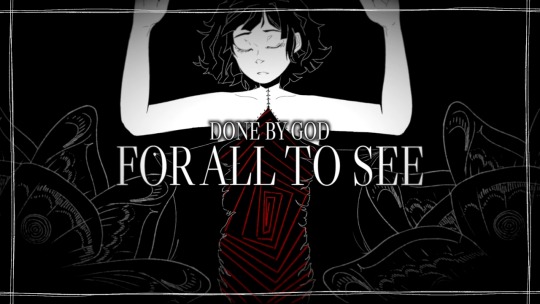
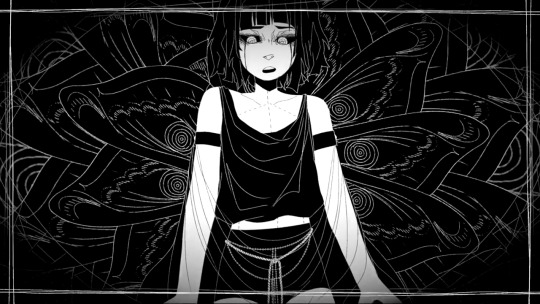
[Image IDs: three seperate screenshots of Honey I'm Home's PV. One shows Norman normally, one shows Norman with his chest sliced open for vivisection, and one shows Norman in a different outfit with scars from where he was cut open. All three images feature prominent patterns of concentric circles of moth wings. End ID]
We see Norman prominently surrounded by moth wings, even after he's been vivisected and transformed. Nearly everything what visually significant about Norman changes: he's gained a halo, lost his bandages and any scars that were underneath, is showing way more skin, and has black scleras and no glasses. His posture is even inverted--in each shot he's lifting a different hand, and the early Norman is confident or vindictive while the second is meek or remorseful. And yet, the moth wings remain. They're in *identical* places in the two shots that have Norman at the center of the frame. The moth is a part of Norman, even after God's scooped him out.
Also worth noting is that Norman's transformation makes him more visually similar not to the angels, but to God himself.
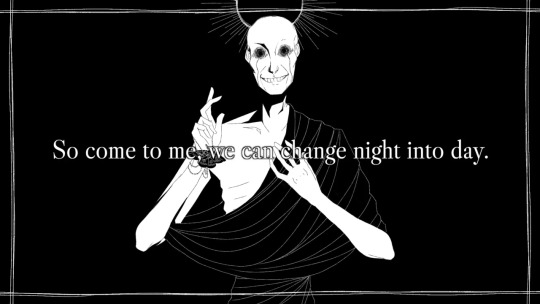
[Image ID: God as he appears in the Honey I'm Home pv. He is a gaunt figure with an eerie grin and dark circles instead of eyes. Black lines run down his cheeks like tears, and he wears loose, flowing robes that expose one shoulder. End ID]
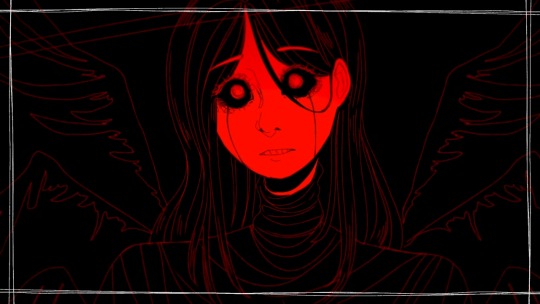
[Image ID: the angel from the Honey I'm Home pv. They have the same dark eyes and tear lines as God and Norman post-transformation, but they instead wear a tight turtleneck. End ID]
Everyone allied with God, and Norman after his transformation--they all have the same eyes, with black scleras. Everyone except Charon has tear tracks. But Norman dresses like God more than anyone else-- his outfit appears to be made of the same material, and also exposes skin.
One last note before I tie this all together: vivisection is an INCREDIBLY loaded word. Scientifically, it's the act of making a v-shaped cut through a living organism's torso to view its innards--think a dissection on something living or a highly invasive biopsy. But just Google the word, and the connotation becomes immediately apparent: vivisection, as a term, is chiefly used in biomedical trials on animals...or to refer to illegal organ harvesting and medical torture in humans. The word is specifically used when referring to several different kinds of unethical human experimentation, which I'm not going to go into because I would rather not be triggered this late at night. Needless to say, Norman is straight up not having a good time with whatever's been done to him, even if you ignore the shot of post-vivisection Norman looking something awful.
So what does this all mean? Literally, we see the tale of a boy running from an abusive home life into the arms of a God and a spider who transform him for their own purposes against his will. Metaphorically, it's how many religious organizations and cults treat the disenfranchised. They lure victims in with promises of safety and light that are impossible or too good to be true. But if a person is desperate enough for help, they can be made to believe anything--that your abusive father can be knocked aside with enough prayer, that your God can turn night into day. A normal church gives you shelter and lets you out at your leisure. An abusive church or a cult blackmails you into staying, by threatening your eternal soul, or your possessions, or by giving you the kiss of death from a poisonous spider named after the man who ferries you to Hades. So, if you're trapped, you stay, and cave to more and more demands, until you're hollowed out and made into the image of what they want you to be. And many people extracting themselves from this kind of abuse report gaslighting--that they were convinced by their spiritual leader that the world was against them, and that the only place it's safe to be is in the fold, away from the world and from retaliation by the people who say they love you. It's just that much easier to be drawn in if you're following in your family's footsteps.
I can't wait for the next song in this series, solely because of the angel we see at the end. They're clearly aware enough to be disturbed by what they're seeing--there's a good chance we'll see the other side of the coin, of how terrifying God and Charon can be.
But when it comes down to it, everything Norman does makes perfect sense. He looks for sanctuary, and he finds it. From his point of view, it probably didn't seem like that big of a sacrifice just to have somewhere he could call home. A twisted home it may be, but it's a home.
#ghost#ghost and pals#honey I'm home#norman minecraft#what tags do y'all use!! i want you to see this!!!#lowkey i wish i could send this to my old genre studies professor#he'd love it#meta#kelley.txt#this is the best post I've ever written#religion //#abuse //#surgery //#ask to tag#human experimentation //#torture //#long post
246 notes
·
View notes
Text
Top 10 Films of 2018
This is rather delayed (mainly on account of an extended bout of laziness on my part), but I was still determined to get it out there! While I don’t think 2018 quite reached the heights of 2017 (nothing matched The Last Jedi or Blade Runner 2049, for example), there was still a lot of great cinema.
As always, keeping this list at 10 meant I had to omit some great titles. Just so you get an idea of what I had to leave out, here are some honourable mentions: Eighth Grade, Lady Bird, Revenge, Phantom Thread, Thoroughbreds, Lean on Pete and Game Night.
1. Roma, dir. Alfonso Cuarón
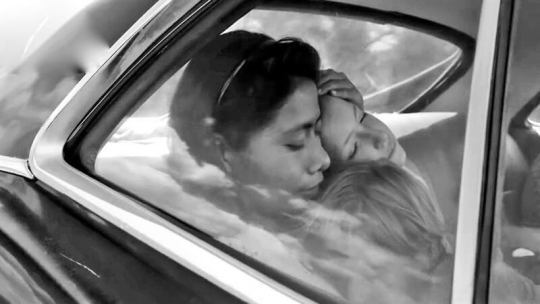
Roma is a deeply special film, and I’m very fortunate in having got to see it in the best possible circumstances - projected on a huge cinema screen, with its gorgeous, silvery cinematography a marvel to witness. This film takes the kind of life that would usually be forgotten and turns it into an epic, interweaving the story of a loving, resilient housemaid with the seismic political events unfolding in Mexico in the early 1970s. The shots are highly symmetrical and geometric, with characters passing in and out of pre-established frames. But this is clearly intentional, and - to me at least - the story felt no less personal for it. There are several all-time great scenes in this film, and while I don’t want to spoil any of them with extended descriptions, I will say that there’s a sequence in a hospital that balances the mundane and the monumental in an extraordinary and heartbreaking way. This is breathtaking, masterful filming, and I felt it did justice to Cleo’s life without ever attempting to claim her experience. The film is quiet and the dialogue is almost perfunctory, relying heavily on its visuals - it’s cinema at its purest.
2. Annihilation, dir. Alex Garland
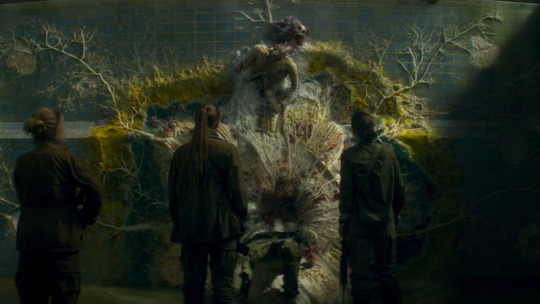
True story: I was so desperate to see Annihilation in a cinema that I flew to New York for it. Of course Annihilation wasn’t my sole reason for travelling to New York, but you can be damn sure I made a point of tracking down an Alamo Drafthouse that was showing it. And boy was it worth it. This movie does a magnificent job of fulfilling the potential of sci-fi, taking otherworldly concepts and ideas and using them to interrogate some of the most profound and frightening truths of what it means to be human. This movie has a quietly hypnotic quality to it, and Natalie Portman continues to prove that she is one of the finest modern actors - she says so much with her face and her movements that lines are hardly necessary. I will continue to follow Alex Garland’s career with great interest...
3. Beast, dir. Michael Pearce

Beast was probably my biggest surprise in film in 2018 - I went in expecting nothing, and was bowled over by it to the point that I rushed out to see it again at the first opportunity. This film follows lonely outsider Moll and her ardent love for the mysterious Pascal. There is a heightened, almost supernatural, quality to their romance, and the actors - Jessie Buckley and Johnny Flynn - have electric chemistry. This film delights in playing with the viewer’s fears and suspicions, constantly adjusting them as the characters evolve over the course of the movie. It’s a great fusion of genres - mystery and romance - that also functions as a superb character piece, and it is entirely worth your time.
4. Bad Times at the El Royale, dir. Drew Goddard
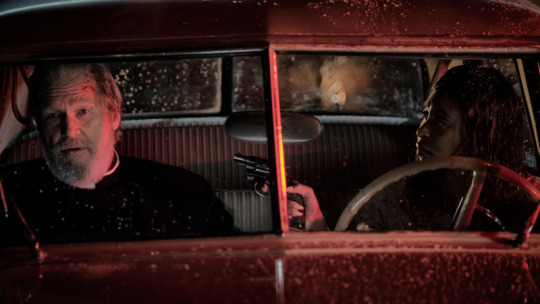
This film is bonkers in an amazing way. A bunch of seemingly random strangers gather at a hotel that’s far from its glory days, and it isn’t long before all hell breaks lose. The ensemble here is terrific, with all the cast members playing off each other in a succession of utterly delightful ways. Every character conceals a secret history and motive, with their layers gradually being peeled back as the movie plays out. Special mention must go to Cynthia Erivo, who is simply stupendous as a session singer who I wound up considering the film’s real hero - she’s marvellously charismatic and complex, and her voice is a complete wonder. This film is a messy tangle of mysteries, and I had a wonderful time unravelling them.
5. First Reformed, dir. Paul Schrader
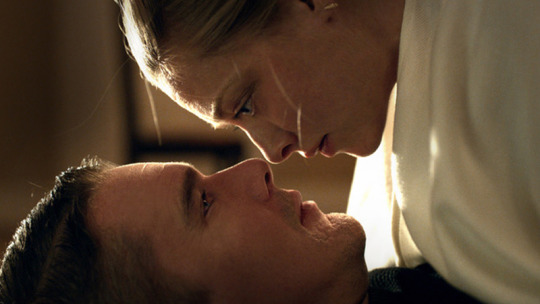
I have a weird soft spot for ‘crisis of faith’ movies (think Silence), and this is a very fine entry into that niche. Ethan Hawke is superb here as a priest attending to an old church that has effectively been reduced to a chintzy tourist attraction, and I found the depiction of how he struggles with his faith, overwhelmed by disillusionment and the immense crises facing the earth, fascinating and beautifully written. Schrader wrote and directed this film, and it is one of his greatest achievements - the dialogue probes deep, never feeling trite or obvious. I also appreciated how the spiritual was so often conflated with the personal, with a thin line drawn being drawn between the divine and the carnal (that end scene is a woozy thing to experience). It’s a beautifully judged film, made all the more fascinating for its ambiguity.
6. Won’t You Be My Neighbor?, dir. Morgan Neville
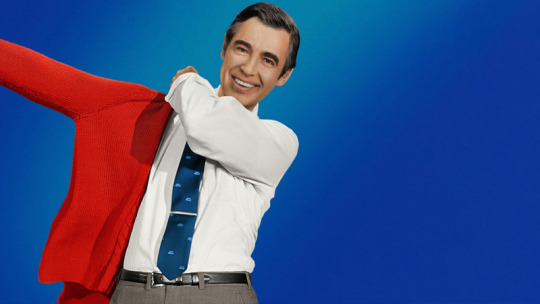
The greatest testament to the power of this wonderful, good-hearted documentary is probably that I went into it knowing practically nothing about Mr Rodgers (he just wasn’t a thing here in the UK) and left it thinking he’s the hero the world needs right now. I’ve seen so many documentaries illuminating the ugliest parts of humanity that I didn’t realise how much I needed one spotlighting the best bits. But this documentary isn’t pure sentiment, though there’s a lot of that - I found a lot to admire in Mr Rodgers approach to child psychology and education, particularly his conviction that every child can benefit from a warm, steady presence, even of the source of the reassurance happens to be trapped in a TV monitor. I can only hope this inspires a fresh wave of documentaries on similarly worthy subjects.
7. The Wife, dir. Björn Runge
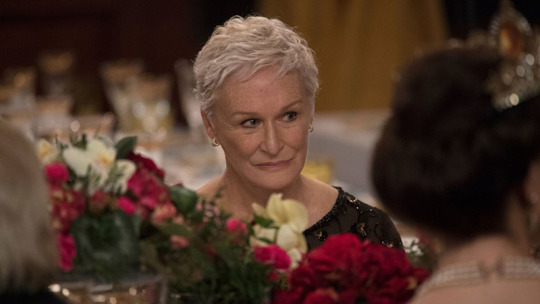
Glenn Close is coming for that Best Actress Oscar and no one can convince me otherwise. With The Wife, the whole movie transparently rests on the shoulders of one woman - Close’s performance is almost sphinx-like, being enigmatic and low-key to the point that her emotions are almost invisible. But their failure to manifest doesn’t mean they don’t exist, and that is perhaps the point of the whole movie. Joan Castleman might seem like the ideal wife of a great author, but she is revealed to be far more than that - a singular individual with dreams, passions, ambitions and regrets. Glenn Close makes the gradual reveal of each facet magnetic, to the point that the slightest twinges of her facial muscles become potent symbols.
8. Blindspotting, dir. Carlos López Estrada

This is an urgent, gripping movie that tackles some of the biggest issues there are. Collin and Miles are friends, but this film sees their friendship challenged, the dynamics underlying it interrogated. I’ve seen movies described as “empathy machines” before, and Blindspotting is a great example of that. It sucks you into the day-to-day experience of living Collin’s life, whether he’s getting a window into the hang-ups of the people whose belongings he is moving (he drives a moving truck) or just chilling out with his friends. Alongside this, it also portrays how terrifying it is to live as a black man in America, how vanishingly little value appears to be placed on your life by those in authority. There’s a rap scene at the film’s climax that consolidates all of Collin’s rage and hurt, and it truly packs a punch.
9. American Animals, dir. Bart Layton

This film portrays a very different side to young American manhood from Blindspotting. Instead of living from day to day, the protagonists of this film start out with pretty much everything they could need - stability, support and good prospects. They choose to unsettle their existence by staging an outrageous heist, clearly dreaming of becoming legends and injecting excitement into their comfortable lives. American Animals does a fantastic job of pulling their plan apart, and since it was based on a true story director Bart Layton does something quite ingenious - he combines real interviews with re-enactments, the filmed scenes being switched out and adjusted according to the conflicting testimonies. In this way, American Animals becomes much more then a depiction of entitled young men seeking to mythologise themselves - it also functions as an interrogation of truth, and the myriad deceptive qualities of cinema.
10. Mission Impossible: Fallout, dir. Christopher McQuarrie
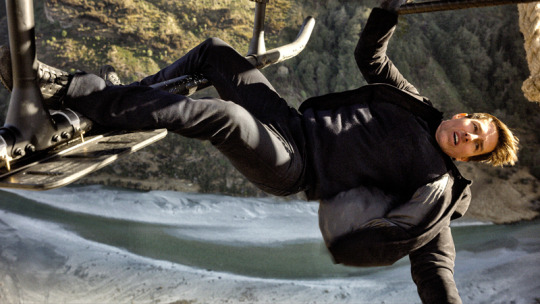
I have no idea how this franchise keeps on stepping up its game, but it does. It reminds me of how the James Bond films ended up taking Bond to space. I can see MI doing that at this point, except we all know that Tom Cruise would actually fly into space for it. With that prelude out of the way, I just need to stress what a fantastic action movie this is. The set-pieces here are marvellously staged, and their execution made them absolutely gripping - I was anxious over every punch, flinching at every cracked bone. McQuarrie is a true master of tension and suspense, and the movie was simply a magnificent ride. I was lucky enough to see this in IMAX with @bastila-bae, and the mere thought of people watching this on smartphones fills me with the rare kind of sorrow known only to shameless film snobs.
Look out for highlights from 2019 - coming up in a few months!
#roma#film#cinema#movie#movies#film in 2018#review of 2018#annihilation#beast#first reformed#blindspotting#mission impossible:fallout#american animals#bad times at the el royale#personal#the wife#won't you be my neighbor
126 notes
·
View notes
Text
What the fuck is the hexagram ritual?: a guide
By reader request, welcome to the sequel to my guide on ‘What the fuck is the LBRP?’, taking you from a five to a six (Thelemites will appreciate the numerology there). I answer a less-asked but still equally common question: what the fuck is the hexagram ritual?

Recalling that the pentagram is a star with five points, the hexagram is one step up from that, a star with six points (d’oh). In the classic Western paradigm, while the five points of the pentagram represent the elements (including Spirit), the points of the hexagram are typically understood to represent the seven classical planets—
Wait, how the hell do seven planets fit into six points?
—I’m getting there. The six points represent (in clockwise order from top, based on the Golden Dawn/Thelemic schema) Saturn, Jupiter, Venus, the Moon, Mercury, and Mars, while the Sun is represented by the centre of the hexagram.
Hence the hexagram and the pentagram generally work on two different levels: the elements making up the pentagram are right here, with us, in this material realm. The hexagram, representing the planets, are out there, floating in the great inky space that lies beyond.
In other words, the pentagram primarily represents our microcosm: the hexagram, the macrocosm.
Okay, who made that shit up?
Probably the Golden Dawn. Ish.
This assignation of the points isn’t arbitrary: the modern Hermetic Kabbalah assigns planets (including the modern ones, i.e. Uranus, Neptune and Pluto – yes, Pluto) or the Sun or the Moon to each of the Sephiroth, or spheres on the Tree of Life.
The Tree of Life?
It’s hard to explain Hermetic Kabbalah concisely and satisfactorily here, so I’d recommend a book such as Lon Milo DuQuette’s The Chicken Qabalah of Rabbi Lamed ben Clifford. In essence, the Kabbalistic Tree of Life is a diagram that visually represents the ten spheres (the Sephiroth) that embody the process of how creation emanates from the original Source, i.e. God with a really big G. Imagine a light shining through ten different filters, the last of which crystallises it into the thing we perceive as Creation.
It’s probably easier to show you:

Do you see the hexagram in the middle of the Tree, centred around Tiphareth/the Sun? That’s exactly where the hexagram correspondences come from.
I thought you said ten spheres – why are there eleven? Also, Uranus is at the top point, not Saturn.
... because Daath (‘Knowledge’), the sphere to which Uranus is assigned, isn’t a ‘real’ sphere, so to speak. The theory is rather more than this primer can cover, but in short, Daath is more of an ‘illusory’ state that sits right on the gap between the spiritual consciousness attainable by humanity (culminating at Chesed) and the ‘pure’ Divinity that lies beyond the veil separating us from the source of all things. This is the gap known as the Abyss, and is a trap for any spiritual seeker. The next 'real' Sephirah after Daath is Binah, which in Thelemic cosmology is also the seat of Babalon, the Great Mother, who assists us safely beyond the Abyss. This is why Saturn takes the top point where Daath should be – it’s the culmination of the journey over the Abyss.
The Earth isn’t included in the correspondences, because the Earth is a given: we have our foot planted firmly in Malkuth, the realm of physical manifestation, of this tangible world around us. This is where the four classical elements live, and where we are. It is from here that we have a base from which to manipulate the six spheres above us, and being rooted here ensures that the higher influences in our lives are balanced, pleasant and stable.
So how does the hexagram ritual fit into all of this?
Easy-peasy: just as the LBRP is our key ritual to balancing and harmonising the influences of the four elements in our life, the hexagram ritual is our key to accessing the power of the macrocosmic forces of the planets.
I’m not actually going to post the full ritual text here, as it would make clutter this post, but you can find it here, in Crowley’s Liber O. Note: Make full use of the illustrations included by Crowley.
Blimey, looks complicated.
... it’s a lot less complicated in practice.
To break it down, the ritual opens and closes with a series of steps known as the Analysis of the Keyword, which is essentially an enacted analysis of the symbolic meanings of the word INRI (which, if you know your Christianity, was the abbreviation the Romans placed on the cross of Jesus, identifying him as Iesus Nazarenus Rex Iudaeorum, ‘Jesus, the King of the Jews’). Thelemistas has a fantastic analysis which I won’t repeat here, but if you have any questions feel free to drop me a DM or an ask. But in short, the Analysis of the Keyword is a method of accessing and drawing down macrocosmic energy. It’s like making sure you’re the right shape of plug before you stick yourself into the power socket of the universe. Terrible analogy, but you get the point. It’s analogous to the Qabalistic Cross in the LBRP.
What’s with all the Egyptian stuff?
Blame the Golden Dawn again.
The Cliffs Notes version is that the Golden Dawn was deeply influenced by the major developments in the study of ancient Egypt – and fashion for Egyptian ~aesthetics~ – that exploded during the Victorian era. There was a strong association of Egyptian religion with the mysteries of life and death (for good reason, however), and so its pantheon and symbols became a language for expressing the mysteries that the Golden Dawn was obsessed with.
Isis, Apophis and Osiris don’t just represent three deities – they are also symbolic of a process of deification and rebirth. Isis is the Mother that generates, Apophis the Serpent that destroys, and Osiris the King that is reborn. And of course, the initials spell I-A-O, a Gnostic god-name that appears everywhere in the Golden Dawn and in Thelema.
After the opening Analysis of the Keyword, you go to each of the four quarters and, as with the LBRP, draw hexagrams and vibrate ARARITA.
AR— what?
ARARITA, the notariqon, i.e. acronym for Achad Rosh Achdotho Rosh Ichudo Temurato Achad, a Hebrew phrase sometimes translated ‘One is his beginning. One is his individuality. His permutation is one.’ The meaning and analysis of this phrase is beyond the scope of this post, but perhaps it would suffice to point out that the word has seven letters. Now, where did we just see that number?
Oh, I know! [answer redacted]
Yup. It all comes back to the [answer redacted].
Okay, great. But what’s with all the triangles? Some of these aren’t actually hexagrams ...
Technically they are; they’ve just been sort of ‘deconstructed’. I don’t myself know exactly why or how they’ve been taken apart the way they are (answers on a postcard, please), but as you can see the interlocking triangles of the hexagram have been rearranged to form four ‘variants’ that are each assigned to a different element. My theory is that, for example, the hexagram for Fire has two upward-pointing ones, which symbolises the upward-moving nature of the element.
I thought we were done with the classical elements.
... I know, I lied.
Well, I kind of didn’t. We are done with the classical elements, or rather, we’re done with the four elements as they exist in our regular mundane world. We’re looking at these elements as symbolic of more idealistic, transcendental realms – this is why they’re assigned to different cardinal directions from the LBRP. In the LRH, Fire is in the East, Earth to the South; Air is in the West, and Water is in the North (as opposed to the LBRP schematic, with Air=East, Fire=South, Water=West, Earth=North). This assignation is based on where the four fixed signs of the Zodiac are found: Leo (Fire), Taurus (Earth), Aquarius (Air) and Scorpio (Water).
It shouldn’t be a surprise now that we’re talking about the zodiac signs: we’re operating on a macrocosmic plane now, where the stars and the planets are.
One thing we should also point out: another possible reason why the two triangles are taken apart is because they technically are two separate symbols: an upward-pointing triangle and a downward-pointing one. In the traditional Golden Dawn association the former should be visualised in red, symbolising Fire, and the latter should be visualised in blue, symbolising Water.
Crowley, being the sort of person who wasn’t going to be tied down by such silly things as traditional correspondences, suggests in Chapter 69 (yes, I know: Crowley being Crowley, this isn’t actually an accident) of The Book of Lies that the magician swap these associations around, so that the upward-pointing triangle is blue and the other one red.
... the descending red triangle is that of Horus, a sign specially revealed by him personally, at the Equinox of the Gods. (It is the flame descending upon the altar, and licking up the burnt offering.) The blue triangle represents the aspiration, since blue is the colour of devotion, and the triangle ... is the symbol of directed force.
The fuck.
Do what thou wilt, mate.
Anyway, unlike the LBRP, there is then no invocation of archangels or anything after the quarters are called: we simply return to the Analysis of the Keyword, neatly closing up the ritual by going full circle (ha-ha). My theory is that because the LRH functions on a macrocosmic, and thus more conceptual level, there is no need to invoke figured beings to ‘ground’ or personify the work.
Thanks, I’m cool with the symbolism now, sort of. But how do you use all this ... stuff?
My own understanding of how one employs the LRH draws on the work of Scott Michael Stenwick on the ‘operant field’. According to this technique the LBRP and invoking form of the LRH (or LIRH) are employed in tandem as a standard opening to ceremonial work. The LBRP clears and creates the vacuum within which magical work occurs, while the LIRH opens up a channel to ‘higher’ energy, rather like plugging yourself into a spiritual power-point. Put another way, the LBRP proclaims your decision to perform magic to the ‘lower’ realm, and demands that your work remains unsullied by it, while the LIRH then announces your intention to the ‘higher’ spheres of power and invites them to charge your work with pure energy.
The operant field technique is in my experience a powerful and effective method of initiating any ceremonial work, and is just good practice in general.
What about the banishing form of the hexagram ritual?
Most of the time I’ve used the banishing form of the LRH is when I’m pretty sure I’ve fucked up some planetary magic and/or an imbalance of planetary energies are causing trouble in my life, or in my magical work. I wouldn’t advise using it too much, if only because the level on which this ritual operates means that trivially employing the banishing form is rather like using a gun to kill a fly.
At the end of the day, it’s all about using the most appropriate tools for the most appropriate purpose. Hopefully this guide has given you some idea of what the hexagram ritual is appropriate for.
Just don’t use it to kill a fly. A swatter will do.
#ritual magic#ceremonial magic#thelema#golden dawn#the lesser ritual of the hexagram#hexagram#astrology#planetary magick#operant field
385 notes
·
View notes
Text
Deadwater

In my last post, I said something that should have given you pause. When describing spirits of the dead, I said, “They can even be exploited if a magus is so inclined. If they can't learn to chill even after they're dead, fuck 'em.”
No one told you that being a magus makes you a nice person, right? There are reasons why necromancy is reviled by many cultures. Most of those reasons are bullshit based on fear and control. But being a necromancer does sometimes mean blurring some lines. If you as a magus decide you may need a weapon at your disposal, even just for self-defense… well weapons come at a price. A weapon is not an innocent thing, despite what the NRA wants you to believe. A weapon always requires you to compromise your innocence. A weapon symbolizes you are willing to do harm. A spiritual weapon can be a costly thing indeed.
The most powerful weapon in my spiritual arsenal? Without a doubt – Deadwater. What is Deadwater you ask? Lucky for you folks I know the leading expert. The number one source. I turn you over to the words of my beloved brother, Frater Yaramarud, the man who provided me with this amazing substance.
“My first encounter with Deadwater came nearly a decade ago. At the time, I saw it purely as a novelty and not something with the nearly boundless potential that I know today. Traveling down the road with my good friend Frater Dreadnaught, and an ex-partner of mine, the three of us had made a late night decision to stop at the next cemetery we found in order to waste time in a way that people in their early twenties are wont to do. When we finally found one and had parked the car, a light in the center of the cemetery had drawn our attention to a pump well gently illuminated beneath it. My initial thought was one of curiosity and bewilderment. What reason could there possibly be for there to be a well here? With this question unanswered, it dawned on me that the corpses surrounding us had, beyond any doubt, decayed and seeped into the table from which this well drew.
After jokes and general fucking around, we left the cemetery without even noting its general location. Though I had lost contact with my ex-partner, Fr. Dreadnaught and I remained close friends. During this time, he had enlisted in the military and left our home state for roughly 7-8 years. Though we often discussed the possible location of the Deadwater, the only thing that either of us could remember was the highway that it was most likely located on. With him gone for years and me being the only person that could feasibly find this place, I did all I could do in order to locate it. Driving up and down the highway proved fruitless, as did looking at maps of cemeteries along the route and cross-referencing them with Google. My last effort was to post an inquiry on a local genealogy group under the guise of searching for the grave of a relative. This too led to nothing. I was forced to give up, and so it was for about six years.
Last year, however, things changed. Fr. D had moved back from California and had spent some time living with my wife and I. It was during this time that we had become determined to find this Deadwater once again. As we had both evolved in our magickal practice, it had become less of a curiosity and more of a holy grail; here was a tool that had so much latent potential, and yet it was completely out of my reach. One night in September of 2017, we had decided that, since it was once again physically possible for us to find it together, we would do exactly that.
I'll spare you the details of the ritual itself suffice to say that Fr. D and myself had performed a Goetic invocation for executing our will. In hindsight, we had made a mistake. For our statement of intent, I had simply said, “It is our will to invoke XX to lead us to the Deadwater located along Highway XX.” It was during the ritual that I was mentally given a map of the county through which the highway ran, with a marker placed by the demon. With the image still firmly visualized, we pulled up a map of cemeteries in the county that this marker could possibly represent. After making a list with their corresponding addresses, we left in search of the Deadwater.
It was the middle of nowhere; we were surrounded by corn fields in every direction. After taking the final turn, still flanked by corn on either side, the GPS indicated that we had arrived at our destination: the first cemetery on the list. There was nothing. Just corn. As Fr. D was rechecking the address, I slowed the truck to a stop. Just before we had become entirely motionless, the field opened up to reveal the stones we were looking for, but they weren't familiar at all. There was no light in the center. It was just darkness. Despite this, we decided to look around anyway. After all, we had the entire night to look, and maybe the light had burned out, or our memory of the place was faulty.
We spent roughly 30 minutes wandering between the gravestones, splitting up to cover more ground. As we both began to lose hope and had called out that we should go to the next address on the list, I noticed a dim light in the distance. I called to Fr. D to meet me and we could explore this light together. Once we had reconvened, we started walking together towards the light. Not even ten steps from when we started, our headlamps simultaneously crossed, revealing before us a pump well.
This was not the same well. We both knew that, and yet a shiver ran down both of our spines. We tested it. It worked. The demon had shown us the way, though due to our lack of precise wording, it was not the same well we had seen all those years ago. We had prepared for this moment and filled several bottles with the water, water that contained the decayed remains of hundreds of bodies, water that was the distilled essence of the dead.
Since that night, I have utilized the Deadwater in multiple ways. The first ritual that we had done with it was a joint effort between Fr. D and myself. He had volunteered to drink a small portion of the water, and a ritual was formed around this primary action. Performed twice, we discovered through Fr. D's gnosis that he was able to visualize and speak to his own ancestors. Thus, not only did this water stand as an essence of the dead that I had discovered through my own later experimentation, it was able to form a link between their realm and our own.
Its apparent linkage to death and focal point of death have proven invaluable. Apart from the aforementioned use of contacting one's ancestors, I have used it as a method of simplifying my altar. Rather than having dozens of pictures of my ancestors for veneration, I find it just as effective to place a bottle of the water with an image of my family crest as a sort of condensed fetish. Another similar use I have found is mixing the water with the gravedirt of my grandmother in order to form an anointing solution that has a direct link to my lineage and those that came before. In using it as a kind of “essential oil of death”, I have found that it works with great success in “jinx” or “hex” work as a medium for freezer spells and the like. It has also worked equally well as an intensifier for other gravedirt workings and as a component for spirit work. Though these cover only my own current experiments with the Deadwater, I know that its potential has exceeded every expectation that I have had for it. As I continue to find new uses, it continually astounds and amazes me.”
What’s the first lesson to be learned from this amazing story? Have a tribe! There are other awesome magi out there. You can find them. It will take hard work and dedication to actually work together. I travel thousands of miles a year just to be with my tribe. But it’s so damn worth it when you experience that love and are gifted with magical knowledge, and receive gifts like 750 ml of Deadwater.
Lucky you, you can buy it online from Frater Yaramarud at his most excellent store, Welcome to Tarotdise, where he and his wife sell some amazing hand-crafted occult products.
Back to the original point and my experiences with Deadwater. As far as I know I am only the second person dumb enough to drink some of it. I immediately tasted the earth and rot of the grave. My vision dimmed, and I felt myself slipping between the land of the living and the realm of the dead. All from one sip. BTW, I in NO WAY endorse drinking the Deadwater. It is not sold for consumption. If you get intestinal parasites or a fungal infection, that’s your problem.
Meditating on the bottle sitting on my altar has produced some interesting visions. You can literally see the angry spirits swirling around in the bottle. No, they are not happy to be there. And I get the feeling the Deadwater captured some of the most malicious spirits of that particular cemetery. Is it wrong to use them for my own devices? Probably. But a magus gotta do what a magus gotta do. I’ll talk some more about the nuances of such necromantic work in a later post.
In my opinion, Deadwater is essentially spiritual toxic waste. No other spirit I know likes to go near the stuff. I really don’t want to meet the spirits that would enjoy it. For example, I recently had an altercation with a certain Red Goddess who has been fucking with my love life hard. Of course, she laughed at my admonitions of her cruel little games. Until I threatened to pour some Deadwater over her statue. She shut the fuck up real quick after that. Is it truly a threat to a goddess? I don’t know, but I certainly got the impression she wouldn’t enjoy the experience.
As noted, Frater Yaramarud had somewhat different experiences. Maybe it’s the batch I got. Maybe it’s his intent when using it, or how he mixes it with other substances. Maybe those spirits just don’t like me for whatever reason. You don’t have to use it as a weapon.
Yeah, I know a lot of this sounds a bit crazy. But part of being a magus is learning to frame your experiences in a mythic context. As my hero Miguel says, “Write your own story. Live your own myth.” Be hardcore. Get yourself some Deadwater. Better yet, harvest some of your own. Be prepared to do a lot of banishing before and after you do something like that.
42 notes
·
View notes
Text
Ending the Session (Chapter 2)
Fandom: Yu-Gi-Oh!
Characters/Ships: Gemshipping (Thief King Bakura/Ryou Bakura); Ryou Bakura, Thief King Bakura, Atem, Yugi Mutuo, Zorc Necrophades
Rating: T
Length: Chapter 2 / 3; 2400 words
Summary:
Into Ryou’s lonely apartment comes a spirit, an ancient power that speaks and manifests through the Ouija board kept beneath the bed. It calls itself Tou, and claims to be human. Ryou believes.
Read on AO3
Previous Chapter – Next Chapter (Coming Soon~)
Chapter Two: A King of Thieves
For nearly a week, Ryou spoke to the spirit daily—sometimes twice daily. Yugi commented that Ryou seemed happier, when they met for coffee. Ryou shrugged off the comment, mumbling some half-truth about doing well in his classes. In reality, his homework hadn't been getting done with quite the level of diligence he usually held himself to.
Ryou hadn't learned much about how the spirit, Tou, had lived, but it didn't much matter. He had learned, in his estimation, many far more important things. Tou was pragmatic, for instance, and jaded, but had an unexpectedly lively sense of humor. At first Ryou had struggled to detect the spirit's jokes, through the toneless board. But he'd also grown far more attuned to the feel of Tou's presence, in his apartment, and fancied that he could sense Tou's general emotional state.
It worried Ryou that the spirit would grow suddenly tense, at times; would flicker with what appeared to be anxiety, or at least agitation, and usually request and end to the session. While Tou always offered fatigue as the explanation—and sometimes it was; Ryou could feel the weight of the spirit's exhaustion—those times were different. Ryou wondered what could cause a spirit like Tou to feel that way, and decided he had no basis with which to even form a hypothesis.
"i know whats keeping me here..." Tou had said, "and its not a thing you can help me deal with..." Ryou wished that that weren't true, but accepted it nevertheless, and so didn't pry.
Ryou stood, one evening, at the stove, preparing diner. The apartment was quiet. He was looking forward to speaking to Tou, later, but for the moment was quite enraptured in his cooking. The sizzling strips of meat made a pleasant crackling, and Ryou hummed along with the sound. They filled the apartment, too, with a heady aroma of meat and herbs, and Ryou bent in over the stove to assess whether or not he needed to add more of any particular seasoning before checking his rice on the rear burner.
The pepper grinder, on the far side of the counter, struck the ground with a jarring crash, and Ryou jumped. He looked around; heard nothing, save for the sizzling of beef in the pan. He glanced down at the pepper, rolling pensively across the floor.
"Tou...?"
The pepper grinder picked up speed suddenly—bumped into Ryou's foot. He smiled.
"Give me a second, okay?" Turning back to the stove, he lowered the heat; checked his rice again, and then scampered from the room. When he returned, he had the Ouija board tucked under his arm. He placed it beside the bloodied cutting board on his counter and opened it.
"Hello, Tou!"
"your dinner smells maddeningly good...” was the immediate reply, and Ryou chuckled.
"Is that all you wanted to tell me?"
"its important...” The pointer moved rapidly, a challenge to read, even for someone as practiced as Ryou. "youre a really good cook...”
"I didn't realize you could smell."
"i can hear and see and smell... i just cant touch or taste... no body yknow..."
"Fair enough."
"i want some of your dinner so badly i could die..."
"I wish you could join me," Ryou said, honestly.
There was a pause, and Ryou tilted his head; waited patiently. He could tell that the spirit hadn't left.
"thanks for talking to me...”
"Of course!" Ryou said, surprised. "I'm happy you want to talk to me, too!"
"its not so common for humans to contact us... not so common for them to be so open either... usually they get freaked out the first time they manage to make contact and then never do it again and usually theyre these stupid kids drunk or just real jerks not the likable type at all...
It was a long, rambling message, and Ryou waited for the pointer to still. Then he said, "I've used the board a lot. I've gotten responses, before, but never a spirit who's come back more than once or twice, let alone actually initiated the contact. It's really nice!"
Again, there was a pause, and when the pointer moved it did so rather slowly. "how do you know im not a bad spirit...”
"I don't, I guess, not for sure. But I don't think you are."
"when i told you i was called tou that was a bit of a lie... half a lie...”
"Oh?" Ryou tilted his head; waited for the spirit to continue.
"i was called touzokuo... king of thieves...”
"Oh. That's a cool title."
"cool you say cool...” The pointer moved so fast it almost jarred Ryou's hand free, and he jumped. "hahahahahaha... youre weird you know that... king of thieves is what they call a bad guy... i was a bad guy when i was alive...”
"That doesn't mean you're a bad spirit, now that you're not alive," Ryou said patiently, and the pointer fell still. There was the faint smell of something beginning to burn.
"youre a kind person to say that... but you should be careful... i had quite a reputation as not only a thief... but a killer..."
"I don't sense any blood-lust from you now, though," Ryou said, and the spirit was silent. "You aren't a bad spirit. I may not have any way to know, but I'm sure of it."
The pointer stayed still, for another moment, and then moved toward "goodbye." Ryou hurried to ask another question before it got there.
"What was your favorite food, when you were alive?!" he blurted—the first thing that came to his mind. To his relief, the pointer stilled.
"roast pig..." was the slow response, after a beat. Ryou smiled, relieved.
"Really? I'm more of a dessert person, myself, but savory foods can be really good. Especially when you're hungry."
"aha... thats very true..."
"Were you hungry, a lot? Is that why you became a thief?"
"dont try to make excuses for what i just told you..."
"I'm not," Ryou huffed, a bit indignant. "I just want to know you better. I want to understand you."
"i was hungry..." the thief said, after a moment. "i was angry too... i wanted to get back at the whole world..."
Ryou considered that, then said, "I wish you could join me, for supper."
"your foods starting to burn... you should get that... itd be tragic to ruin it..."
Ryou nodded, but as he went to leave the board, some near-physical force held his hand to the pointer.
"r-y-o-u" the spirit spelled out, with a force that surprised the human boy. "end the session... never leave without saying goodbye... youve used the board enough to know that..."
Ryou hesitated, then nodded. "Sorry. You're right, of course... Goodbye, Tou."
And the pointer, in response, moved to, "goodbye".
... ... ...
Ryou stifled a yawn; popped a piece for chocolate into his mouth, and took a swallow of coffee. The apartment felt unusually empty—devoid, in a rare moment, of spirits. And, though he knew he should sleep, Ryou had to take the opportunity to do research while he had the apartment to himself. So there he sat, at his desk, the light of the computer screen tinting his white hair light blue.
"King of Thieves... Thief King... Touzokuo..."
So far, he hadn't found any historical figures matching those titles, but they were sufficiently vague enough to render standard search engines all but useless.
It was three in the morning; Ryou took another sip of his coffee.
'Didn't he say... wait, that garbled message...'
Scrabbling through some papers beneath his bed, Ryou found the notebook he'd had during his first conversation with the spirit that called itself Touzokuo. He returned to his desk, then looked at the word that hadn't made any sense, at the time; the word he'd assumed to be some sort of spiritual typo: nedjem.
Ryou ate another piece of candy; it had a pressed brown sugar center inside of milk chocolate, and he let it melt in his mouth, feeling the graininess as he rubbed his tongue against the roof of his mouth. He typed "nedjem" into the computer, and hit enter.
At first, nothing interesting showed up—the search engine tried to autocorrect his query to needed. So he tried "meaning of word nedjem," and hit enter once again.
A... carob pod...?
Ryou's eyes widened slightly as he stared, surprised, at the hieroglyph that had appeared on his screen. He clicked on the first result, and read aloud, "Ancient Egyptian hieroglyph signifying 'sweet,' represented visually by a carob pod and thought to be said as 'nedjem.' One instance documents a doubling of the symbol, presumably read 'nedjemnedjem,' to indicate a pleasing concubine."
Ryou took a deep breath; tasted the sugar thick on his tongue, and took a drink of coffee to wash it down.
Ancient... Egypt...
It made sense, the more he thought about it. Though he'd passed off the spirit's reference to Anubis, Anubis being a fairly well-known symbol of death even in modern times, it made a lot more sense if he considered it as an influence of the spirit's original culture.
So what did I ask? Why "nedjem"?
He had asked what the spirit was called—Tou. He'd asked what the spirit was—h-u-m-a-n. He'd asked if the spirit had made contact with the living before—once or twice.
Ryou ate a marshmallowy piece of candy that got stuck in his teeth, and momentarily distracted himself getting it out with his tongue.
Then, it struck him.
"youre odd... different from others ive talked to..."
"Really? How so?"
"n-e-d-j-e-m"
Ryou's hands flew to his face, and he tried not to read into the odd answer, now that he knew what the long-extinct word meant. After a few more fruitless internet searches, he'd worked himself into enough of a frenzy that the mere thought of sleep was impossible. And, the internet having failed him, he reached for his cell phone and knocked his pencil holder off his desk in the attempt.
... ... ...
"Hnn..." Yugi Mutou raised his head as his cheerful ringtone cut through the silence. He dragged himself to the side of the bed, ignoring the bleary, angry muttering of the man sleeping beside him, and observed the time on the glowing screen—3:47—and the name. "Unh... Ryou-kun...? What is it...?"
"Yugi-kun! Ah, I'm so sorry, did I wake you?"
"Ryou-kun, it's almost four in the morning..." Yugi stifled a yawn; listened to his friend squeak and shuffle frantically on the other end of the line.
"I-I'm so sorry! I-I forgot, for a second... haha! I can call back tomorrow, if—"
"Ryou, I'm awake. What's up?" Yugi settled in, arms folded beneath his chin and atop his pillow.
"Ahh—! O-Okay, then... well... has Atem ever mentioned a legendary Thief King, from Ancient Egypt?"
"Thief King?" Yugi echoed, and was startled when his bed-partner bolted suddenly upright. "Atem! What's—?!"
"Who's on the phone, Yugi?"
"Great Ra..." Yugi breathed, and Ryou made a questioning sound. "Hey, Atem just woke up... Do you want to talk to him?"
"Oh Yugi, that would be wonderful! Are you sure he wouldn't mind?"
"Give me the phone, Yugi," Atem commanded, though his eyes were shadowed with sleep and his hair was sticking out to the side, as opposed to his usual vertical spikes.
"He wouldn't mind at all," Yugi told Ryou, and then held out the phone to his boyfriend.
"Oh! Atem! Sorry to bother, at this hour, I just... got all caught up, and—"
"Out with it, Bakura," Atem commanded, and Ryou squeaked. "What's this about the Thief King?"
"I just... well, you're an Egyptologist, after all, and that's where you're from, anyway, so I figured if anyone would know anything about—"
"Where did you hear about the Thief King, though?" Atem demanded, and Ryou swallowed audibly.
"So there is something..."
"Bakura, tell me where you heard that title," Atem said, his voice low and almost threatening. Yugi pulled worriedly at the sleeve of his nightshirt.
"I just... I mean... a friend. A friend mentioned him." Ryou's voice was shaking.
"Don't lie to me, Ryou Bakura."
"Atem, don't scare him," Yugi implored. "You know how he is..."
"O-Okay..." Ryou began hesitantly. "Y-You know how I like to play around with Ouija boards, occasionally...?"
Atem scrambled up; stumbled from the bed, much to Yugi's increased distress, and cursed as he tripped over a discarded piece of clothing. "You didn't. Tell me you're not going to say what I think you're about to say, Bakura. Tell me you don't have the spirit of the Thief King in your apartment."
"Well, not at this exact moment, but—"
"Great Ra!" Atem fumbled with his coat; threw it on over his nightclothes as Yugi began to follow him from the bed. "Okay, Bakura, I need you to leave that apartment immediately, do you understand? I'm coming to get you."
"Wait, what?!" Ryou spluttered, and Yugi called out his boyfriend's name in confusion. Atem ignored them both.
"This—this is why Ouija boards have a bad reputation, Ryou," Atem continued, hopping into his shoes. "You've gone and summoned something bad, now, something very bad, and—"
"Tou wouldn't hurt me!" Ryou objected suddenly, and Atem cursed.
"Listen to me, Ryou—the so-called Thief King is a demon-god. You know I was a pharaoh in a previous life, don't you? I lived during the same time as the Thief King."
"You knew him?!"
"I killed him, Bakura, when he tried to kill me! After he—!" Atem cut himself off; muttered a curse. "He isn't human—he's a demon, as I said, a demon called Zorc, who took on human form to kill the pharaoh—to kill me, and those I loved."
"That doesn't make any sense!" Ryou objected.
"He's deceiving you! He's the best damned liar I've ever met in any lifetime, believe me, and now he's lying to you! I'm coming over, okay? You stay on the phone with me now, and—Bastet!" Atem cursed.
Yugi—a few steps behind him, on the way to the door—yelped. "What?!"
"Little asshole hung up on me!" Atem fumed; handed Yugi his phone. "Try to call him. We're going to his apartment."
"Atem, is he... really in danger...?"
"Not unless he's done something really stupid like opened a portal..." Atem muttered, flinging the door open and flying down the apartment stairs, Yugi on his heals. "Gods... let him be safe... I can't lose another friend... not to that bastard Thief King... not in this lifetime..."
9 notes
·
View notes
Text
The Definitive Guide to face mask
Working with vinegar like a pores and skin toner dates back to the time of Helen of Troy, and it’s equally as powerful right now. When you clean your face, mix 1 tablespoon apple cider vinegar with two cups drinking water as being a ending rinse to cleanse and tighten your skin.
The Face Mask are utilized by the overall health treatment staff members for facial safety in opposition to airborne infections. These face masks are developed with the quite gentle substance which makes it possible for air movement in this kind of way that the user won't sense suffocation.
Wrestling masks are used most generally in Mexican and Japanese wrestling. face mask for skin is normally connected with a wrestler's persona (such as, a wrestler known as 'The Panda' might use a mask with a panda's facial markings).
Throughout the globe, masks are used for his or her expressive electricity as a element of masked overall performance - the two ritually and in various theatre traditions. The ritual and theatrical definitions of mask utilization routinely overlap and merge but still offer a helpful foundation for categorisation.
Over the Renaissance, masques and ballet de cour developed - courtly masked entertainments that continued as Portion of ballet conventions right up until the late eighteenth century. The masked figures on the Commedia dell'arte incorporated the ancestors of the trendy clown. In modern day western theatre, the mask is commonly used alongside puppetry to create a theatre which is essentially visual as opposed to verbal, and many of its practitioners have been visual artists.
One highly critical element of Lecoq's usage of mask, was not a great deal of its Visible effect on stage, but the way it transformed the performers motion on phase. It was a entire body-dependent approach to mask operate, rather than a visually led one.[forty six][50] Lecoq's pedagogy has actually been hugely influential for theatre practitioners in Europe working with mask and has become exported greatly the world over. This work with masks also pertains to executing with portable buildings and puppetry. College students of Lecoq have continued employing masks inside their operate after leaving The college, such as in John Wright's Trestle Theatre.
Big measurement Beard Internet crafted from breathable medical quality non woven material. Gentle comfortable thread elastic for safe positioning and ergonomic healthy in excess of the person's face.
You can also get a much better comprehension of the solution by dealing with valuable person created responses. Immediately after finalizing your alternative, possess the item delivered to your doorstep and full the transaction by making use of just one of numerous effortless payment options. Discover the finest pores and skin care goods on line by purchasing at Amazon India.
Thoroughly coat your face Together with the mixture, Allow dry fully, then rinse with warm drinking water. Your face will truly feel new and rejuvenated. Discover the ideal DIY face masks For each kind of pores and skin worry.
In some spots, annual shamanic ceremonies included masked dances and these strongly abstracted masks are arguably probably the most hanging artifacts manufactured in this area.
Head to some posh spa and you'll deal with oneself (for a mere $100-$three hundred) to an all-over overall body scrub. Or it is possible to commit nearly $fifty on a flowery system scrub. Why invest in when you can make a do-it-yourself entire body scrub outside of essential substances oneself? face scrub may need is salt or sugar, system oil and a nice, warm tub.
In this article, I share 18 incredible makes use of for simple substances you can find during the kitchen area. Make your individual toddler wipes, get a recipe for your lip scrub, give by yourself a steam by using a teapot and a lot more.
Pacific Northwest Coastal indigenous groups were generally hugely expert woodworkers. Their masks were being frequently master-pieces of carving, in some cases with movable jaws, or a mask inside of a mask, and components moved by pulling cords.
Although the Dogons and Bamana folks the two imagine the antelope symbolises agriculture, they interpret components the masks in different ways. On the Bamana people, swords symbolize the sprouting of grain.
Not known Facts About face mask
Curly, frizzy or straight hair, just about every terrific hair fashion begins while in the shower. That’s why you’ll have to have to guard and take care of your hair with the ideal hair care merchandise like shampoos and conditioners. There are a variety of shampoo and conditioner formulas which will help you take care of uninteresting or harmed hair. Whether it is shampoos, conditioners, hair oils, hair colours, styling resources or treatment method merchandise, you’ll find all of it on Amazon India underneath one roof to your convenience. Obtain on the net hair care and styling items, filter outcomes depending on model, cost, purchaser reviews or Exclusive gives and special discounts.
In Gals of shade, skin may possibly appear ashy or uninteresting from dead skin buildup. These face masks, combined with regular exfoliation and everyday utilization of moisturizers should really soothe dry, chapped skin.
Our available item is extensively tested on numerous parameters by our expert quality controllers to make certain flawlessness. What's more, our available merchandise is extensively appreciated in the professional medical and surgical apps.
Japanese masks are Element of an extremely old and extremely subtle and stylized theatrical tradition. Although the roots are in prehistoric myths and cults, they've got designed into refined art varieties.
To be able to fulfill the at any time transforming demands of our customers, we are actually engaged in production and exporting a wide gamut of Face Mask.
Head to the posh spa and you may treat your self (for your mere $a hundred-$300) to an all-over physique scrub. Or it is possible to expend nearly $fifty on a elaborate entire body scrub. Why buy when you can make a home made overall body scrub away from fundamental ingredients yourself? All you will need is salt or sugar, entire body oil and a good, warm tub.
They tend to be worn about the face, although they could also be positioned for effect in other places about the wearer's body. In portions of Australia, giant totem masks deal with your body, while Inuit Girls use finger masks throughout storytelling and dancing.[1]
The distinction with performance masks will not be constantly crystal clear-cut. Ritual and theatrical masks them selves can be regarded as being realistic, and protecting masks within a sporting activities context especially are frequently designed to enhance the looks of the wearer. Clinical
To the Aztecs, human skulls had been prized as war trophies, and skull masks weren't unheard of. Masks have been also used as Section of court entertainments, possibly combining political with spiritual significance.
Ritual masks take place all over the entire world, and Even though they have an inclination to share a lot of properties, very distinct varieties have made. The purpose with the masks may very well be magical or spiritual; they may look in rites of passage or being a make-up for the type of theatre. Equally masks may perhaps disguise a penitent or preside over vital ceremonies; They could enable mediate with spirits, or present you with a protecting position to your Culture who utilise their powers.
For https://www.rosiehope.com/its-all-practice/diy-coffee-scrub-face-mask (and tasty!) therapy, mash up A few ripe strawberries with three tablespoons of ground almonds. Increase two tablespoons of yogurt and mix till the mixture contains a pasty texture.
Distinctive styles of masks began to arise in pre-Hispanic The usa about 1200BC, Whilst You can find evidence of considerably older mask varieties.
Then wipe it off and rinse with interesting drinking water. Your face will sense clean up and clean. Not sure which a person of those masks will perform most effective for the skin? This is often the most beneficial face mask for every pores and skin sort. Yogurt facial masks
Robbers together with other prison perpetrators often put on masks as a means in concealing their faces and therefore identities from their victims and from law enforcement.
About face mask
Owing to your abundant encounter and understanding In this particular area, we have already been ready to provide ideal top quality Face Mask to our prestigious consumers.
Get a list of critical oils that get the job done for all skin types. Not all crucial oils operate for all skin varieties. Some could melt away or hurt delicate skin, by way of example.
As a tradition of scattered islands and peninsulars, Melanesian mask forms have created in the really diversified trend, with a substantial amount of wide variety in their development and aesthetic.
Copeau, in his attempts to "Naturalise" the actor[forty nine] decided to use mask to liberate them from their "too much awkwardness". Subsequently, Copeau's operate with masks was taken on by his college students which include Etienne Decroux and later on, by means of Jean Daste, Jacques Lecoq.[forty six] Lecoq, acquiring labored as motion director at Teatro Piccalo in Italy, was affected from the Commedia custom. Lecoq met Amleto Satori, a sculptor, they usually collaborated on reviving the approaches of constructing traditional leather Commedia masks. Later on, establishing Copeau's "noble mask", Lecoq would ask Satori to help make him masques neutre (the neutral mask). For Lecoq, masks grew to become a significant instruction Resource, the neutral mask becoming made to aid a condition of openness in the scholar-performers, shifting progressively on to character and expressive masks, And at last to "the smallest mask on earth" the clown's purple-nose.
Throughout the world, masks are applied for their expressive electrical power being a attribute of masked performance - both equally ritually and in several theatre traditions. The ritual and theatrical definitions of mask use often overlap and merge but nevertheless provide a beneficial foundation for categorisation.
They are frequently worn on the face, Whilst they may also be positioned for influence somewhere else over the wearer's system. In parts of Australia, huge totem masks protect the human body, whilst Inuit Girls use finger masks all through storytelling and dancing.[one]
In the cult of Shiva, found in Anatolia from circa 6,000 BC, the young, naked ithyphallic god seems in a horned mask.[15] Within the Greek bacchanalia as well as the Dionysus cult, which associated using masks, the common controls on behaviour were being temporarily suspended, and other people cavorted in merry revelry exterior their regular rank or position. René Guénon claims that inside the Roman saturnalia festivals, the normal roles were normally inverted.
In certain places, annual shamanic ceremonies included masked dances and these strongly abstracted masks are arguably by far the most putting artifacts generated With this region.
Ergonomically shaped Z Additionally face mask with easy adjustable nose piece. The outer layer as well as the internal layer includes physiological harmless comfortable non-woven material.
Solutions and Masks offered in the market at present are of the very best order and can play An important role in influencing your Total appearance. Amazon India gives you many of the most effective skin treatment products that can actively impact your grooming and allow you to accomplish quite possibly the most out of your physical appearance and skin tone. Store on the internet at Amazon India to locate the very best treatment options and masks.
Why squander revenue on high-priced creams when you can take care of oneself to some calming homemade face mask with full-egg mayonnaise from your have fridge? Carefully distribute the mayonnaise more than your face and go away it on for about twenty minutes.
Pat your face with gentle yellow mustard for a bracing facial that should soothe and stimulate your skin. Try it on a small exam place very first to be certain it won’t irritate. Lemon facial masks
There are a wide variety of masks used in Africa. In West Africa, masks are used in masquerades that kind part of spiritual ceremonies enacted to talk to spirits and ancestors. Illustrations are the masquerades from the Yoruba, Igbo, and Edo cultures, which include Egungun Masquerades and Northern Edo Masquerades. The masks tend to be carved with a rare talent and range by artists who will usually have received their training as an apprentice to your learn carver - often it is a custom that has been passed down in just a family by lots of generations.
With the Aztecs, human skulls were prized as war trophies, and cranium masks were not uncommon. Masks were also applied as A part of courtroom entertainments, quite possibly combining political with spiritual significance.
1 note
·
View note
Text
“It’s all in the movie”: Jungian themes & Reylo in The Last Jedi
Disclaimer: I was going to revise this meta and bring it up to date as my ideas matured through further reading, but it’s no longer the case. This text exists as is, and I’m not going to come back to it.
Abstract
In this post I will be mostly focusing on Jung’s principle of individuation (becoming the whole, true self) and how it aligns with the relationship between Rey and Ben in The Last Jedi. In the process I will also be discussing some of the symbolism, how I interpret it and how it ties in with the overall theme of individuation as a possible narrative arc for this film.
Also please note that I have tried my best to provide sources to all the quoted material which can be accessed online, free of charge (and is in English). I very much encourage you to dig deeper and come to your own (informed) conclusion.
Introduction
I think this particular thread of thought found its beginning after I had seen TLJ for the first or second time, and before I had seen any mention of Jung. For some reason the Praetorian Guards were drawing away my attention from Ben and Rey.
Everything about them is highly ritualistic. From the way they manifest a specific kind of symmetry, to the red color that is a legacy of the Imperial Guard from which they originate. But their armor is something else entirely. My mind immediately drew a parallel with samurai armor, and I was thrilled to find out that it was actually something they used as a reference:
“The Praetorians, my brief to [costume designer] Michael Kaplan was that those guys have to be more like samurai. They have to be built to move, and you have to believe that they could step forward and engage if they have to. They have to seem dangerous.”
- Rian Johnson
But there is also something else. I kept seeing dragons.
Yes, there is a lot of highly stylized stuff in Star Wars, but if you simply look at the lines, and the way the armor is constructed, it’s hard not to see the visual references. Particularly evident in the arm guards, cuirass and helmet. And this sort of stuff doesn’t just get thrown together. The design process for such things can take a long time, and always involves a number of people. It is considered from the aspect of storytelling and the significance of a scene or moment in the greater narrative. What something has to evoke or convey and the impression it has to make. Which is why I’m not at all hesitant to also look for the intended meaning of the scene in costume and setting as well.
In addition, Rian has said that this was definitely one of the most significant scenes in the film and one that he is very proud of for pulling off the way they did:
And look, there were a lot of people whose work went into it to design the space and the guards, the stunt work, but that was a moment that I had just always held dear to me, and it’s one of those very rare things where the realization of it on screen I just feel like, “Ah, we got it!” It makes me happy.
- Rian Johnson
The Subconscious
So now, coming back to the dragon. There are several ways to interpret dragon symbolism (which in some sources is not differentiated from the serpent in general), but a few particular and reoccurring interpretations align quite well with Rey and Ben’s arc(s).
Dragons often symbolize the subconscious and a certain fear that is felt towards it. Fighting one then stands for facing your own most base impulses, the unknown part of your psyche that you have to conquer in order to really be in control of your whole self, and not just led by half of your instincts.
Psychologically, however, the archetype as an image of instinct is a spiritual goal toward which the whole nature of man strives; it is the sea to which all rivers wend their way, the prize which the hero wrests from the fight with the dragon.
- Carl Jung, Collected Works, Vol.8: Structure & Dynamics of the Psyche
In the follwing (letter to pastor Jakob Amstutz) referring to the dragon as the subconscious:
It is as though consciousness were aware that the dragon is the lower half of man, which indeed and in truth is the case.
- Carl Jung, Letters Vol.I, pg.489
In Jungian theory a dragon just so happens to be a symbol for the process of individuation, which stands for the integration of soul and ego. And this is a fight Rey and Ben take on together, the two of them fighting against the dragon again alluding to them as two halves of a greater whole. Suggesting that they are also connected to each other in the process of becoming their true selves, beyond simply the extent to which the Force is concerned. The Force is a part of their connection, but I would consider it more of a mediator of their innermost selves. The reason for the depth of their bond lies in them, in who they are, and who they could become with the support of the other.
It does not mean that it is something the narrative is built around exclusively. Or that its presence could be explicit at all times. The Throne Room scene also can’t be reduced to just one set of symbols, so there is more that’s packed in there (including blatant sexual symbolism). But the fight against the dragon is what represents an inner struggle to achieve control over the subconscious. Like the tug of war between light and darkness. To me personally, that is the broader narrative, and something I feel that Rian’s comments have supported as well. Most explicitly perhaps when talking about the significance of what Rey experiences in the cave, something that is very much one of the most telling examples of what I’m talking about here. He said that it’s about becoming, in a very general sense, and also about exploring the infinite possibilities of the self, and finding the true self:
And so it was just an image that came into my head. Of this infinite line of, you know, possibilities of self. And these endless kind of possibilities of identity. And the notion of the playing with which one is the “real” her. Which one is going to be her. And where does it end.
- Rian Johnson
Individuation: Becoming the whole Self
Individuation, as Jung describes it, is a process of psychological development, during which the individual will assimilate the parts of the self into one complete and homogeneous whole and become their truest self. One of the things that individuation aims to do, is to rid the self from the fake layer of the assumed persona (Kylo Ren & the mask, to which I will return later) and on the other hand from the suggestive powers of the untamed subconscious.
Now let’s talk about Modern Man in Search of a Soul, a book Rian said he read as part of his prep for TLJ. So it is indeed “a good place to start”, for multiple reasons. First is of course the fact alone that Rian himself has been explicit about drawing inspiration from Jung. But what’s even better is that in it Jung discusses the necessity of individuation:
The way of successive assimilations reaches far beyond the curative results that specifically concern the doctor. It leads in the end to that distant goal (which may perhaps have been the first urge to life), the bringing into reality of the whole human being—that is, individuation.
- Carl Jung, Modern Man in Search of a Soul, pg.31
There is something else that I really want to point out, not specifically on the subject of individuation, and that is chapter VIII - “Psychology & Literature”. I just immensely enjoy the fact that this is something he said he is drawing inspiration from. So if I may:
In dealing with the psychological mode of artistic creation, we never need ask ourselves what the material consists of or what it means. But this question forces itself upon us as soon as we come to the visionary mode of creation. We are astonished, taken aback, confused, put on our guard or even disgusted - and we demand commentaries and explanations. We are reminded in nothing of everyday, human life, but rather of dreams, night-time fears and the dark recesses of the mind that we sometimes sense with misgiving. The reading public for the most part repudiates this kind of writing - unless, indeed, it is coarsely sensational - and even the literary critic feels embarrassed by it.
- Carl Jung, Modern Man in Search of a Soul, pg.182
Coming back to individuation again, I want to present two particular quotes which both emphasize the importance of communication and the conversational aspect of this process. Which is in my eyes especially relevant to how individuation as a whole aligns with the development of Rey and Ben’s relationship. The Force bond allows them to communicate themselves to each other, and the more they begin to understand the other, they also learn something about themselves.
I quite agree with you: without relatedness individuation is hardly possible. Relatedness begins with conversation mostly.
- Carl Jung, Letters, Vol.II, pg.609-610
Individuation is only possible with people, through people. You must realize that you are a link in a chain, that you are not an electron suspended somewhere in space or aimlessly drifting through the cosmos.
- Carl Jung, Nietzsche’s “Zarathustra”: Notes of the Seminar given in 1934-1939, pg.103
But, there is more here than just the relevance of a conversational aspect. There are 3 stages to individuation, which I think can also be seen in TLJ. Jung himself outlined them as the following:
The search into the unconscious involves confronting the shadow, man’s hidden nature; the anima/animus, a hidden opposite gender in each individual; and beyond, the archetype of meaning. These are archetypes susceptible to personification; the archetypes of transformation, which express the process of individuation itself, are manifested in situations.
- Carl Jung, Collected Works Vol.9i: The Archetypes and the Collective Unconscious, 451 p. (p. 3-41)
I will write about the steps below, but I feel the need to point out that we are simultaneously dealing with two kinds of self here. One is contained within them individually, the other is the greater consciousness or self they become together. That is why I think that the stages are less evident in the two when viewed separately, but become more obvious when they are observed as a whole made of two individuals. They are both part of the same process of individuation, together. They are fighting the dragon as equals, and so their struggles to face their own self are also connected. Not to mention because of the way they are connected by the Force. The balance they would create together is the result of this process in which they are both involved.
1. Assimilation of the Shadow.
This is the first step of individuation. The shadow is a representation of the “dark side” of the personality or human psyche. And all the more negative aspects of the lower half of the self (subconscious), like a compartment saturated with moral and ethical shortcomings, character flaws, shame, abuse and dependency. Assimilation of the shadow means facing the darkness you contain to become aware of all of the parts of your (sub)consciousness in order to integrate them into your whole self.
In the film Rey plunges underwater (water - a prominent symbol for the subconscious) to emerge in the “forbidden” cave beneath Ahch-To where she finds a mirror-like wall in which she sees two shadows approaching. One that is her own, and one that appears to be that of Ben’s. The shadows become one, at which point she sees her true reflection appear.
When it comes to the assimilation of Rey’s own shadow, to me it seems to be depicted rather straightforwardly. At first I was hoping to find a parallel moment in which Ben has a similar experience independently, but then I realized that for him it happens through Rey. And perhaps that is the only way. Because remember, communication is the key to individuation. And him having strayed much farther away from the light, he might not be able to achieve it alone. He needs Rey to help him. She is the other half of the whole, the greater self.
So there is a reason Rey saw two shadows meld into one and then herself. The scene in the cave is followed by that in the hut where Rey tells Ben everything that happened. The hopeless loneliness it made her feel. She is sharing her experience of individuation with him. And the very element of them talking about it over the Force bond is a reminder that their understanding of each other’s experiences goes beyond what they say in words, it is also felt.
In my interpretation of it, it’s through Rey’s experience that Ben becomes able to confront his own shadow (if I go by the mirror scene in the cave.) And so that is a part of why their shadows are shown to meld into one. Because they are parts of the same whole. His experiences affect her and vice versa. I think Ben is overwhelmed by his own shadow which manifests in the persona. This would most distinctly show the emotional stuntedness which suppression has caused. He has become emotionally fractured, so much so that he can hardly figure out the pieces by himself, so he needs the conversationality of the individuation. He needs Rey’s help to find himself again. And it’s an awakening that we see throughout TLJ.
The Eye
There is one more element about the cave scene, that I wanted to mention. Although I’ve seen Freudian readings of it, which interpret the cave through sexual symbolism, my own first association was actually different. To me, the entrance to the cave looked like an eye.
The mind which is in each of us is able to comprehend all other things, but has not the capability of understanding itself. For as the eye sees all other things, but cannot see itself, so also the mind perceives the nature of other things but cannot understand itself.
- Philo of Alexandria, Works Vol.I, pg.76
The hole in the center resembling the pupil, dark and full of the unknown. The growths emerging from it reminiscent of the pattern of an iris surrounding it. And I just thought it to be interesting how it seems to align with the aspect of the light above and darkness below, representing the conscious and subconscious mind:
So whatever comes from behind comes from the shadow, from the darkness of the unconscious, and because you have no eyes there, and because you wear no neck amulet to ward off evil influences, that thing gets at you, possesses and obsesses you.
- Carl Jung, Nietzsche’s “Zarathustra”: Notes of the Seminar given in 1934-1939, pg.1265
So in that way, Rey is entering someplace that her conscious can’t access, where the eye doesn’t see. Diving into the waters of subconscious to reach the mirror in which she finds their shadows. The eye thus representing a doorway into the lower half of the self.
So what Rian said about the cave scene interestingly enough also connects back to Jung:
The idea was if the up top is the light, down underneath is the darkness And she descends down into there and has to see, just like Luke did in the cave, her greatest fear. And her greatest fear is [that], in the search for identity, she has nobody but herself to rely on.
- Rian Johnson
2. Becoming One: confrontation of the anima & animus
The second step of individuation is concerned with the dynamic of anima and animus what in Jungian theory control and shape the relationship between a man and a woman, the male and female. Anima being the representation of the female element of a male’s psyche, and therefore animus the opposite in a woman’s. This is a similar relationship to that of yin and yang.
It is unavoidable, for the purpose of Individuation, that one will know how to differentiate the true self from the self that one allows themself and others to see. For the same reason it is necessary to become aware of the invisible ties one has to their subconscious, specifically to Anima. In order to be able to differentiate oneself from it.
- Carl Jung, my shitty translation of a translation of Die Beziehung zwischen dem Ich und dem Unbewussten before I realized it’s literally the same book as Two Essays In Analytical Psychology *sigh* (Page 97 in my copy, but you will have to find it yourself in the linked text)
Persona & The Mask
In the case of Ben, there is another aspect which plays into the dynamic of self and anima, and that is the persona that is Kylo Ren, that I mentioned earlier. A constructed self created to camouflage the true self, to mask feelings and reactions in order to obtain some type of control over his self-projection. The element of the mask also being literal in this case. Kylo Ren is an attempt to dehumanize himself externally, in order to hide the pain and fear of Ben Solo. Jung also describes the relationship between anima and persona as compensatory. This is why both have to be taken into account.
And this persona is another part in Ben which needs Rey in order for him to let go of it. We also see that happen in TLJ quite explicitly I think. Snoke even calls Ben a “child in a mask”, which is what prompts him to discard it in anger. That moment is an initial reaction and not yet his full realization of the persona, but he is forced to face it. It is his connection with Rey which enables the emergence of himself from behind the mask, and to see something worth wanting that the mask would not allow him to have. Step by step he comes closer to consolidating the persona and the anima.
Awakening of Eros
One aspect of confronting the anima and animus is that it can also be the awakening of Eros. I did not plan on expanding much on that because it goes deep into sexual symbolism territory. But it was something I wanted to point out though.
So, too, man will be forced to develop his feminine side, to open his eyes to the psyche and to Eros, It is a task he can’ not avoid.
- Carl Jung, Collected Works, Vol.10 (Civilization in Transition), Page 125
If you want to understand the sexual imagery in TLJ better or see alternative interpretations to your own, there are well-known blogs that have written about the subject at length.
3. Wise Old Man / Woman Archetype
The third step of individuation involves meeting the archetype of the Wise Old Man or Wise Old Woman. Jung describes such archetypes as “mana-personalities” which are still tied to either anima or animus. In the collective unconsciousness they are interpreted like the inner representations of the same-sex parent and symbolize figures of authority.
The mana-personality is a dominant of the collective unconscious, the well-known archetype of the mighty man in the form of hero, chief, magician, medicine-man, saint, the ruler of men and spirits, the friend of God.
- Carl Jung, Collected Works, Vol.7 Pt.II: Two Essays on Analytical Psychology (Individuation)
In general this last step is the hardest for me to completely wrap my head around. Perhaps because how the archetype can appear in very different forms, and that perhaps also goes for its intention. The intended outcome is also more difficult to outline, outside of the fact that the experience of it has to complete the process or rather journey of individuation.
I’m not going to attempt to translate the whole segment, because it makes my head hurt, but in a chapter dedicated to mana-personality in Two Essays on Analytical Psychology Jung basically describes meeting the mana-personality as something similar to the process of acceptance or admitting something to the self. Also, the manifestation of a mana-personality occurs only if the previous step has been successful, in the process of which the anima has lost its raw demonic power (ibid).
I think it’s possible that this is what we see at the end, the archetypes being represented by Luke & Leia. But that being said, I don’t see the process of individuation as being complete, so the third step may also be something that we didn’t actually see in this film.
Conclusion
To me, it really is all in the movie. I hope to have outlined how and why Jung’s concept of individuation aligns with the relationship between Rey and Ben, their growth individually and together. In that way forming a kind of a narrative arc which implies that together Ben and Rey will bring balance to the Force and to each other. It’s about the whole Self.
______
The Human Shadow and other stories (I didn’t have time to read/listen to most of it yet, but RJ references it so it doesn’t hurt to link it anyway. )
365 notes
·
View notes
Text
Breath of the Wild Music Analysis: Folk Music and Kass’s Theme
Breaking into one of the deepest tracks (Characters?) in the game! There’s quite a bit of historical context to unpack here, so let’s get to it.
Track 13: Kass’s Theme
Genre: Folk, Waltz
Featured Instruments: Accordion
Compositional Techniques: Historical Context
youtube
Truthfully, this track isn’t too complicated composition wise, so rather than covering the composition in depth, let’s delve a bit into ethnomusicology and how it’s implemented into Kass’s theme, and by extension the role of Kass himself. The applications are pretty neat and are very easy to gloss over. In identifying exactly what this track does let’s first set a preface, because this is an info rich post.
An accordion being performed is significant, the fact that Kass is a traveling musician is important, and lyrics play a role in understanding how Kass’s music works. All of these actually interact behind the scenes to create something awesome! So, let’s start by briefly talking about the style of music, because that’s what I’ve been doing. Best to knock it out now.
This track is a Viennese Waltz, or for all intents and purposes a waltz. If you’re even somewhat familiar with basic musical forms or dance, you’ll likely know what a waltz is. Waltzes are marked by a 3 beat pattern, often played at a tempo fast enough to make you feel only one beat at a time. The fact that we can trace this form of music historically to Austria’s capital Vienna will play a little bit of a role later on, but just keep that in the back of your mind for now. You’ll likely recollect that you can hear similar sounding accordion music in a lot of other media, and when you do, it’s often to accompany the performer singing. These vocals are generally easy to understand and will either explain part of a story, or describe a scene that’s going on. Vocals and accordion go pretty hand in hand in many types of music. Again, save that for later!
The melody is very memorable, and obviously is associated with Kass, which keeps us in the realm of more traditional Zelda music. But it’s important to realize that the waltz itself isn’t necessarily overly significant in this case. Waltzes exist in all forms of instrumentation. In fact, if you remember, I explained how the music in the large guardian battles is actually a waltz. Because of this, let’s look to how we could actually tie in the accordion to aspects in Breath of the Wild other than the music itself.
Accordion is often associated with a very wide, sweeping genre of music called folk music. Folk music in many ways might be the widest genre of music possible, as it simply refers to “traditional” music in the confines of western music history. By this association, every nationality has traditional folk music. Because of this, folk music can sometimes be associated with “World Music.” This is not an absolute generalization however, as world music definitely does exist outside of the realm of folk. The easiest way to think of traditional folk music, is as a type of music that is usually transmitted orally, across generations, and performed over long periods of time. Naturally because of this, having a good recognizable melody is everything.
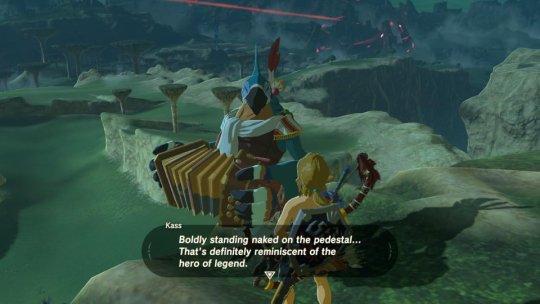
However, transmitted orally is one of the most important things to understand in relation to traditional folk music. In general, the idea behind folk music is it’s a music representative of a traditional culture, music of the past if you would. It’s music that had no way to be recorded other than to be passed down with the intention of future generations remembering it. These are often songs associated with religion, custom, holidays or spirituality, but they’re all passed down by the idea of tradition. The interesting thing about where traditional folk music occurs today is in towns or areas that might be…let’s call it “Old fashioned.” Small, isolated villages are prime targets to find traditional folk music. The thing about Breath of the Wild though, is every village is pretty isolated and each one has a very strong visual and cultural representation in someway or another. Without the influence of many outside sources, this would make each village prime material for cultural folk music. And remember, the accordion is our symbol that relates to folk music itself. Which brings us to its performer Kass.
Kass is a Rito and a traveling minstrel, or musician. His purpose in the game is to learn the songs of the various lands in Hyrule, the songs that have been passed down over generations. Believe it or not, this is actually very similar to a profession called ethnomusicology. Ethnomusicologists generally study the traditional music of cultures or people, doing things like residencies, interviews, or recordings of performances. They’re people who are trying to retain a musical past, one that’s often only translated in person. They hold onto the music we don’t know about, so that one day we can hear it too. It’s often a behind the scenes job, and one that can go easily forgotten.
The neat thing is, because Kass travels to different lands, tribes, and locations to learn about their music, documenting them for future generations, he’s a sort of in game ethnomusicologist.
Kass’s songs tell stories, or provide riddles that help you solve puzzles, but the important thing is that they’re direct lore for Breath of the Wild because they contain lyrics, even if they’re only through text. If we think back to when I talked about Nier: Automata, I said lyrics allow us to provide literary meaning to music, something that you’ll often hear in folk music.
In addition to this, Kass plays a ton of music over the course of the game. You can hear a bunch of different versions of both new and familiar Zelda music. Which…since Nintendo says that Breath of the Wild takes place at the “end” of the Zelda timeline (Don’t get me started on this), it’s very evident that the music in question would also have been passed down through the ages similar to folk music. And for the songs that relate to the regions, those would be direct representations of the tribes’ folk music, passed down over time.
Because of the way he presents the music, both past, old and present. You could stretch it and say all of his renditions of music could be considered folk music. So naturally, let’s stretch this to the breaking point.
One of the songs that can be heard is the main Breath of the Wild theme. This is significant in a way, and although it can be chalked up to the fact that “it’s a different arrangement of the main theme end of story,” this places the song in the game’s world itself. You could then infer that the theme of the wild is actually music that has the potential to be passed down in game as well. It has a strong, memorable melody, and has important association for the game. It’s a direct representation of the soundtrack by our traveling Rito musicologist.
Again, more than likely this wasn’t intended, it most likely was simply “Man wouldn’t it be cool to have him play the main theme as well?” That doesn’t make it any less important though. The best ideas to find are the ones that might not be there.
However, something that does hold great significance is the ending to Kass’s storyline. If you complete all of his challenges, you can find him completing his wish in performing in front of his siblings in Rito village. He starts by playing his theme (with a few variations on articulation,) and eventually goes through some changes before he ends up on the familiar main theme for The Legend of Zelda

Historical contexts are important, and despite what Nintendo says about any timeline, music has always held kind of a historical Easter egg worth of information if you will. And honestly, this is the biggest, brightest egg of them all. We’ve known the main theme for the Legend of Zelda from the very beginning of the series, and it’s made an appearance at some point throughout all of the games. It’s a very important theme, but as you’ll notice it only plays at a few places in the soundtrack. Sometimes for seemingly no reason (Riding the horse,) and others for important locations (Hyrule Castle.)
Throughout our personal histories with the Zelda series, we’ve come to associate this track as one that transcends the games, the timelines etc. We’ve likely made assumptions (even if subconscious) that the theme is present in the world of Hyrule itself, even if it doesn’t always appear that way. But with Kass performing it, you could infer that this is now transmitted music of Hyrule, much like the music of the tribes, legends and history of the now broken Hyrule.
That’s cool.
This has been an overly long exposition, so let’s get into some quick meat of how we can apply this information to our own work.
Essentially what’s being done with Kass is creating lore through music. The songs Kass performs, whether shrine, divine beast, champion, city or whatever related, in someway or another build lore. If we think about the way the story is structured this makes complete sense. If you like, you can actually skip all of the story other than “The kingdom is broken Link. You must stop Ganon.” Or you can take the time to experience as much about about the world and the story as you choose to. Kass’s music is also a direct reflection of this. His purpose is to transmit the music to those that listen, allowing Link, you the player to learn more about the lore of the world. This is a unique way to not only provide more story, but also music that is relevant to the in-game world. Making the music itself a part of the lore.
So why not find ways to incorporate music into lore in our own projects? Admittedly, this isn’t easy, nor should it always be done. There are many ways that it could distract from player experience depending on the project, but if able to be accomplished it can provide a new way for music to be heard, experienced, and appreciated, even if not explicitly noticed. Breath of the Wild does it through a traveling character that develops overtime, but why not find other ways?
Truthfully, Zelda music has always done very well in incorporating music into lore. Playing music in Ocarina of Time and Majora’s Mask are the two most obvious ones, but you can find instances in Wind Waker, Twlight Princess, and the often forgotten Ballad of the Wind Fish in Link’s Awakening.
In these cases, playable music, music association, and direct story implications are three ways to accomplish this. But honestly the possibilities on how to include music into lore are endless. After all, what is music other than retelling a story?
Let’s break it down.
Summary: Kass’s theme is representative of his character who present a unique take on the idea of traditional folk music in the land of Hyrule. Our clues include his instrument of choice, his status as a traveling musician, and that he collects songs to pass on to future generations. This act of passing on songs is a direct representation of lore, as it interacts with gameplay, and can add key story segments to the overall plot. Kass’s theme itself is reflective musically of traditional folk music.
Takeaways for Developers: Consider possible ways that you can build lore through music. There are many ways to do this, and many ways to do this incorrectly. Think about ways that you could place music inside the game’s world itself, and how the music could be representative of your setting, characters or ideas.
Takeaways for Composers: Using influences of folk music is a powerful way to build lore through music. Find ways that music might be able to be directly representative of a group of people, kingdoms, or countries when applicable. Remember the connotations that are carried with folk music. To effectively translate lore through music, it might be easiest to include lyrics, even if only in text.
I’ll come out and say that this has been one of my favorite tracks to listen, research and write on. To be honest, I could unpack even more here if I really wanted to. But I don’t want to make this more of a novel than it already is. Please feel free to reach out with any questions to my DMs, or at [email protected]. I’d love to chat with you!
I’ll be back soon with the next entry in this series~
#breath of the wild#The Legend of Zelda Breath of the Wild#Nintendo#Zelda#Link#the legend of zelda#Breath of the Wild Music#Video Game Music#Music#Folk Music#vgm#VGmusic#game music#Video Games#Music Analysis#Kylydian#Indie Dev#Indie Developer#Indie Game#Game Composer#Game Audio#New Music
6 notes
·
View notes
Photo

So, this was an interesting spread. It’s a bit difficult to make out what all went on in it, but I’ll try my best to go over things as best I can.
I had the feeling the other night to do a spread using my three decks. I thought I’d ask them to tell me three things about myself each that I should hear.
I also wanted to make sure that I focused the energies right, so I pulled out what felt like an appropriate signifier card for each of the decks. Up at the top (the purple one way up there) is The Star from Shadowscapes. I love the art, I love the colors, it just... really resonates with me. And the Star is one of those concepts and cards that speaks to me a lot, so I wanted to include it anyways.
Down at the bottom left (I kind of wish I had flipped the Faerie Enchantment cards over, they look nicer that way, but the information is on the back) is Brighid. “Visualize Inspirational Dreams” is the phrase for her, and she has some fitting correspondences in the deck, purple, amethyst, star. Plus her symbol is a K, which is my middle name. :P So I picked her for the Faerie Enchantment representation.
The bottom right is Phanuel, the Angel of Truth from the Angelarium Oracle. Truth... that’s definitely something I’m looking for. The truth about myself, the truth about others, the universe, the gods, spirits, magic. What does the truth mean in each of those. Is the truth as really fixed as some seem to think it is? Is it all subjective? Many things on this matter I ponder. It also here I feel has an added feeling of making sure the truth about me comes out from the cards. Brighid kind of contrasts in making sure that the ideals come out, but Phanuel balances it so it isn’t more than what is actually so.
Alright, let’s get into it. I started with the middle, Shadowscapes. I wanted to start with the shadow, the blending of light (Angelarium) and dark (Faerie Enchantments). Note that both decks have both, more the vibes I associate with both. Anyways, for Shadowscapes, I got The World, The Emperor, and The Hierophant. Unfortunately don’t have the deck on hand, but there was something in the booklet that really spoke to me about it. It was something like... blending the different songs of the world into a harmony. There are meanings here, in this reading. It talks a lot about potential I feel, balance, love, a lot of things that really resonate with me.
I’ll actually try focusing on The World part of it first. So The World is a truth about me, something I need to know. Like other readings ( @thestarseedoracle knows the ones I mean. :P ), I have a lot of potential I guess. More potential than I am willing to accept sometimes, but that I need to. Possibility, miracles, magic, a blending of different strands myself. A song that shines, a light that sings. Just... I have the World in me. I can do what I need to, I can do what I want to. I have to focus on that potential, and stop being restricted by what sounds “reasonable”. And I’m close to achieving this.
Emperor, another favorite. Command, power, structure, order. A strong masculine energy. I have that in me, something that I kind of struggle with at times. I tend to see myself more like the Empress than the Emperor. But I have the Emperor in me, presumably along with the Empress because, you know, World. But I need to be willing to accept this part of me. And the potential it has. Be willing to use the powers of the Emperor where appropriate, be willing to know when it isn’t serving its purpose.
Hierophant kind of surprised me, though I wasn’t sure who I expected to show up. Perhaps that’s part of why he showed up. I know that the cards are meant to show things I don’t see as much in myself. And this is definitely a card I may have difficulty with. Kind of a similar vibe to the Emperor too. Bridging worlds (another theme I feel came about a bit), spiritual practice, but more of an orthodox kind of thing. But I know that’s something I want to do. Be able to bridge the divine, and help bring it down here. A foot in both worlds.
Faerie Enchantments were a bit more focused. Branwen (Imbue Compassionate Feelings), Aibell (Balance Karmic Harmony), and Penarddun (Attract Empathic Love) were the three that came out. Like Shadowscapes, there are some consistent trends that Faerie Enchantments wanted to talk about. But some overarching trends too.
Branwen, part of the deck talks about how she bridged a divide between two different groups of deities. Light, and dark is how the creator interpreted the two groups, though I haven’t looked into Welsh deities enough to see how accurate that interpretation is. I feel like that was another recurring theme. One of being able to bridge worlds, no matter how different they seem. I can exist in both, I can live in both, or as many as I need. Acting with love is important for that.
Aibell talked about balance and harmony, concepts that kind of relate to that similar theme of disparate things. I know that I have that possibility in me, but it’s hard to really tell how strong it is. Of course the cards would talk about this. Karmic here talked about “dispensing justice” which I think is an important vibe too. To be willing to take action, and make my own calls, even if they seem... well, different I’ll say.
Penarddun is talking about love. My ability to attract love, and why that is. Because I give out what I receive. I share love, as best I can, with anyone I meet. Yet at the same time pull off the Aibell karmic thing, I guess. I don’t know, mystery in the process of unfolding after all. There were some things on the cards correspondences I liked too, evening, butterfly, rose quartz. But I’m being reminded of that love that I have, because I sometimes doubt it.
This leaves the last three. Angelarium. Azrael, Angel of Death. Gabriel, Angel of Heralds. Israfel, Angel of Song. The theme here I feel, is change. It’s rather clear here. The possibility to change things, to make things better, worse.
Death isn’t something I’ve always been comfortable with. I’m still not, though more so than I used to be. But if I’m The World, then Death is there too. I’m being reminded that change is... change. It is loss, it is death. But that it is only through that things can change. Gain and loss occur, and I need to be comfortable with both. And to be comfortable with death more too, if I’m going to be doing all the things I want.
Gabriel is talking about Heralds. Bringing (wait for it) change. Possibility, growth, loss. I feel like here the theme is more about me being an active agent of it, again the push to be out there and doing things. It’s... I need to be more involved, in the World, so to say. But comfortable to be me too, which will not always be out there like that. It’s a process. To be willing to, comfortable with, inspiring others. The next one talks about this some too. There are very strong themes of acceptance throughout the cards.
Israfel is the last card. I considered doing something looking at ways the cards line up, but this is kind of long as it is. Songs. I love music. I listen to it all the time. Apollon is a big (very big) deity for me, and I’m listening to music even as I write this. Hymmnos, a language I love, was created for music, and the songs it has are very moving to me. I love hearing the ways others express themselves. The way they share who they are. The words they use, the words they don’t use. I remember for a while I purposely avoided using the word “home” to avoid talking about where I live, because it wasn’t my home. For all of this love of language and songs, I don’t sing my own song. I don’t shine with my own light. But... I know I have to be willing to. I have to be willing to be me, and express myself. Take action, keep trying, keep being... me. Because I am a good person, even if I don’t think so.
I doubt anyone is too interested in this, mostly for me. Did tag the person I thought might like seeing this. Though I’m happy to hear any other comments.
#divination#faerie enchantments#angelarium#oracle#personal#spiritual#journey#mystery in the process of unfolding
9 notes
·
View notes